Design and Implementation of a Smart Collaborative Robot with AI
VerifiedAdded on 2022/08/26
|28
|5623
|22
Report
AI Summary
This report details the Model Based System Engineering of a smart collaborative robot designed for packaging applications. The project encompasses the development of an autonomous packing robot, incorporating vision, voice, and IIoT capabilities. The report begins with an introduction to the background and scope, followed by the aim and objectives of the project. A state-of-the-art review provides context for the design, and the methodology section outlines the use of Model-Based Systems Engineering (MBSE) and SysML for system modeling. The requirements specification defines the functional and performance requirements of the robot, including payload, vision system, IoT integration, actuating system, and control system. The design specification further elaborates on these aspects, justifying the design choices. The report includes SysML diagrams such as requirement, use case, block definition, parametric, activity, and state machine diagrams to illustrate the system's architecture and behavior. Python simulations and CAD models are also developed to validate the design. The results and discussion section analyzes the performance of the robot. The report concludes with a summary of the project's achievements and potential future improvements. References are provided to support the findings.

Model Based System Engineering of a smart collaborative robot with vision, voice and IIoT capabilities
Secure Best Marks with AI Grader
Need help grading? Try our AI Grader for instant feedback on your assignments.
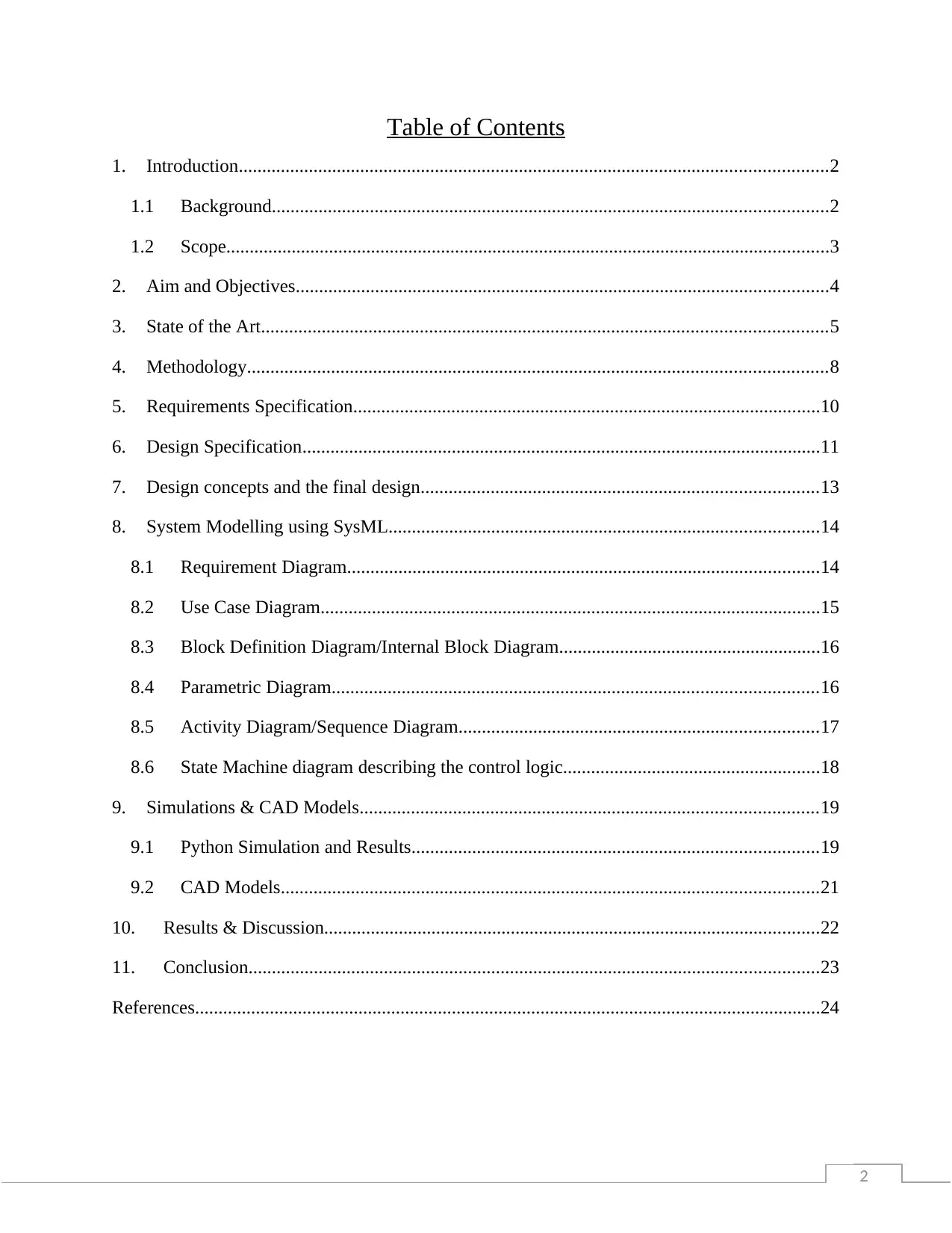
2
Table of Contents
1. Introduction..............................................................................................................................2
1.1 Background.......................................................................................................................2
1.2 Scope.................................................................................................................................3
2. Aim and Objectives..................................................................................................................4
3. State of the Art.........................................................................................................................5
4. Methodology............................................................................................................................8
5. Requirements Specification....................................................................................................10
6. Design Specification...............................................................................................................11
7. Design concepts and the final design.....................................................................................13
8. System Modelling using SysML............................................................................................14
8.1 Requirement Diagram.....................................................................................................14
8.2 Use Case Diagram...........................................................................................................15
8.3 Block Definition Diagram/Internal Block Diagram........................................................16
8.4 Parametric Diagram........................................................................................................16
8.5 Activity Diagram/Sequence Diagram.............................................................................17
8.6 State Machine diagram describing the control logic.......................................................18
9. Simulations & CAD Models..................................................................................................19
9.1 Python Simulation and Results.......................................................................................19
9.2 CAD Models...................................................................................................................21
10. Results & Discussion..........................................................................................................22
11. Conclusion..........................................................................................................................23
References......................................................................................................................................24
Table of Contents
1. Introduction..............................................................................................................................2
1.1 Background.......................................................................................................................2
1.2 Scope.................................................................................................................................3
2. Aim and Objectives..................................................................................................................4
3. State of the Art.........................................................................................................................5
4. Methodology............................................................................................................................8
5. Requirements Specification....................................................................................................10
6. Design Specification...............................................................................................................11
7. Design concepts and the final design.....................................................................................13
8. System Modelling using SysML............................................................................................14
8.1 Requirement Diagram.....................................................................................................14
8.2 Use Case Diagram...........................................................................................................15
8.3 Block Definition Diagram/Internal Block Diagram........................................................16
8.4 Parametric Diagram........................................................................................................16
8.5 Activity Diagram/Sequence Diagram.............................................................................17
8.6 State Machine diagram describing the control logic.......................................................18
9. Simulations & CAD Models..................................................................................................19
9.1 Python Simulation and Results.......................................................................................19
9.2 CAD Models...................................................................................................................21
10. Results & Discussion..........................................................................................................22
11. Conclusion..........................................................................................................................23
References......................................................................................................................................24
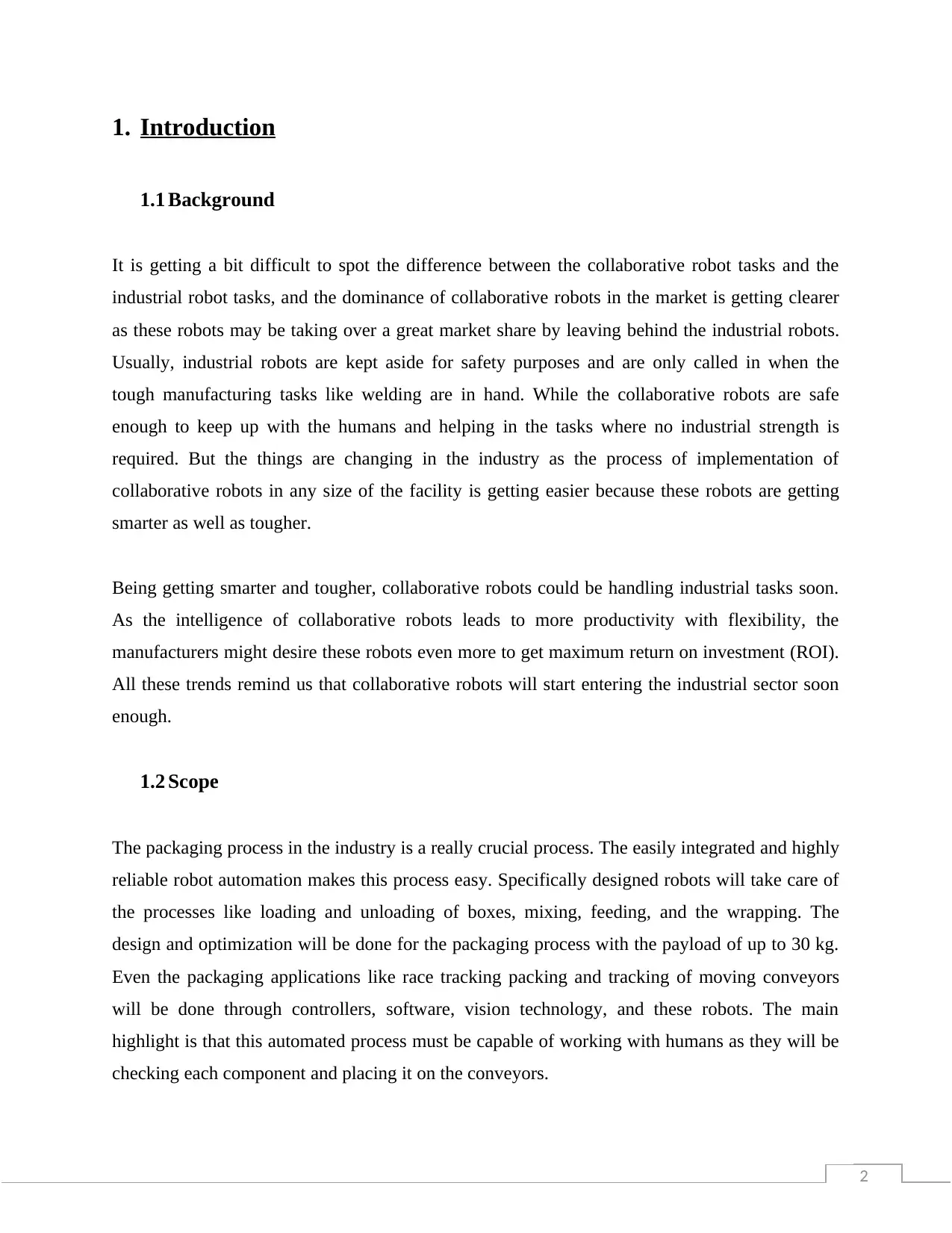
2
1. Introduction
1.1 Background
It is getting a bit difficult to spot the difference between the collaborative robot tasks and the
industrial robot tasks, and the dominance of collaborative robots in the market is getting clearer
as these robots may be taking over a great market share by leaving behind the industrial robots.
Usually, industrial robots are kept aside for safety purposes and are only called in when the
tough manufacturing tasks like welding are in hand. While the collaborative robots are safe
enough to keep up with the humans and helping in the tasks where no industrial strength is
required. But the things are changing in the industry as the process of implementation of
collaborative robots in any size of the facility is getting easier because these robots are getting
smarter as well as tougher.
Being getting smarter and tougher, collaborative robots could be handling industrial tasks soon.
As the intelligence of collaborative robots leads to more productivity with flexibility, the
manufacturers might desire these robots even more to get maximum return on investment (ROI).
All these trends remind us that collaborative robots will start entering the industrial sector soon
enough.
1.2 Scope
The packaging process in the industry is a really crucial process. The easily integrated and highly
reliable robot automation makes this process easy. Specifically designed robots will take care of
the processes like loading and unloading of boxes, mixing, feeding, and the wrapping. The
design and optimization will be done for the packaging process with the payload of up to 30 kg.
Even the packaging applications like race tracking packing and tracking of moving conveyors
will be done through controllers, software, vision technology, and these robots. The main
highlight is that this automated process must be capable of working with humans as they will be
checking each component and placing it on the conveyors.
1. Introduction
1.1 Background
It is getting a bit difficult to spot the difference between the collaborative robot tasks and the
industrial robot tasks, and the dominance of collaborative robots in the market is getting clearer
as these robots may be taking over a great market share by leaving behind the industrial robots.
Usually, industrial robots are kept aside for safety purposes and are only called in when the
tough manufacturing tasks like welding are in hand. While the collaborative robots are safe
enough to keep up with the humans and helping in the tasks where no industrial strength is
required. But the things are changing in the industry as the process of implementation of
collaborative robots in any size of the facility is getting easier because these robots are getting
smarter as well as tougher.
Being getting smarter and tougher, collaborative robots could be handling industrial tasks soon.
As the intelligence of collaborative robots leads to more productivity with flexibility, the
manufacturers might desire these robots even more to get maximum return on investment (ROI).
All these trends remind us that collaborative robots will start entering the industrial sector soon
enough.
1.2 Scope
The packaging process in the industry is a really crucial process. The easily integrated and highly
reliable robot automation makes this process easy. Specifically designed robots will take care of
the processes like loading and unloading of boxes, mixing, feeding, and the wrapping. The
design and optimization will be done for the packaging process with the payload of up to 30 kg.
Even the packaging applications like race tracking packing and tracking of moving conveyors
will be done through controllers, software, vision technology, and these robots. The main
highlight is that this automated process must be capable of working with humans as they will be
checking each component and placing it on the conveyors.
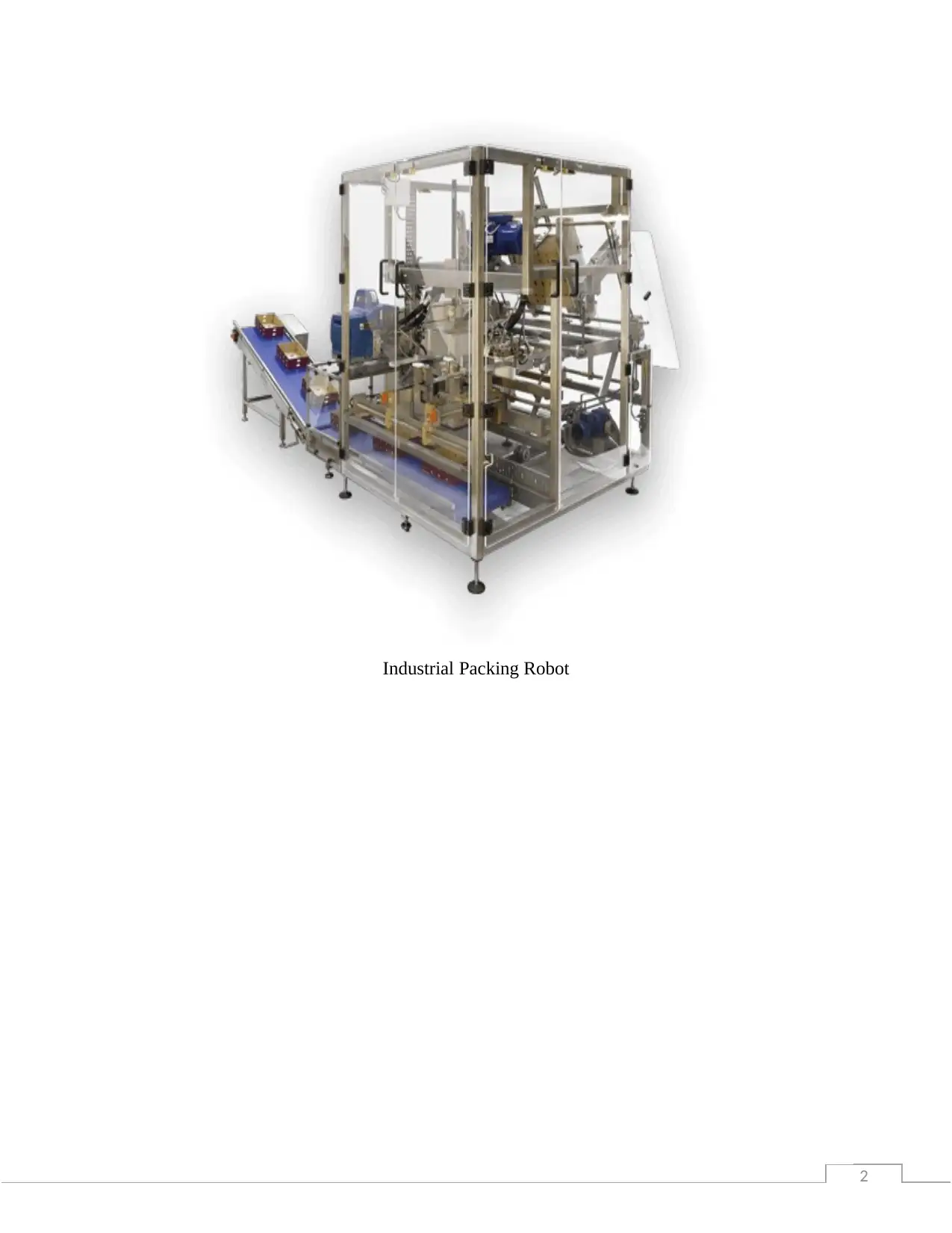
2
Industrial Packing Robot
Industrial Packing Robot
Secure Best Marks with AI Grader
Need help grading? Try our AI Grader for instant feedback on your assignments.
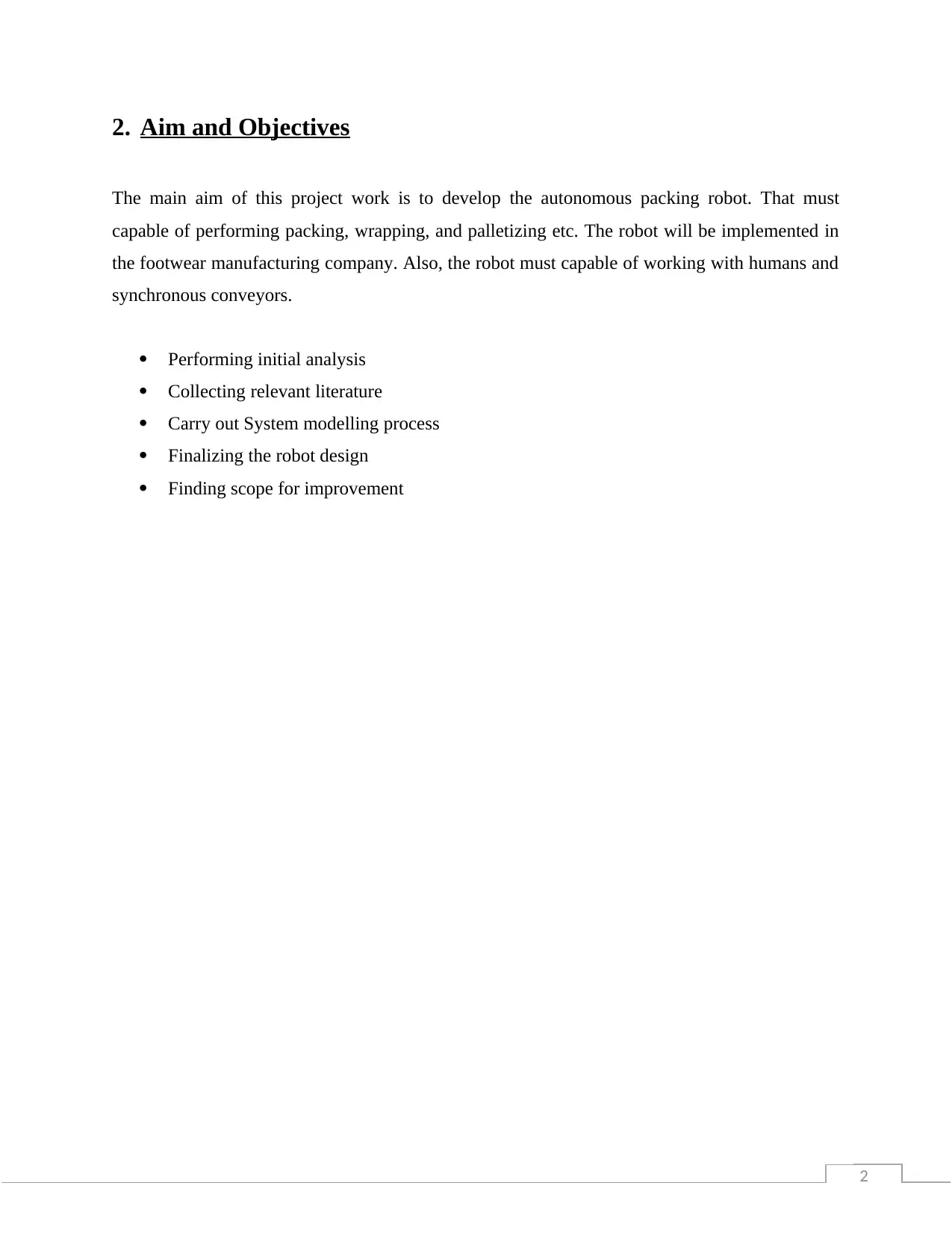
2
2. Aim and Objectives
The main aim of this project work is to develop the autonomous packing robot. That must
capable of performing packing, wrapping, and palletizing etc. The robot will be implemented in
the footwear manufacturing company. Also, the robot must capable of working with humans and
synchronous conveyors.
Performing initial analysis
Collecting relevant literature
Carry out System modelling process
Finalizing the robot design
Finding scope for improvement
2. Aim and Objectives
The main aim of this project work is to develop the autonomous packing robot. That must
capable of performing packing, wrapping, and palletizing etc. The robot will be implemented in
the footwear manufacturing company. Also, the robot must capable of working with humans and
synchronous conveyors.
Performing initial analysis
Collecting relevant literature
Carry out System modelling process
Finalizing the robot design
Finding scope for improvement
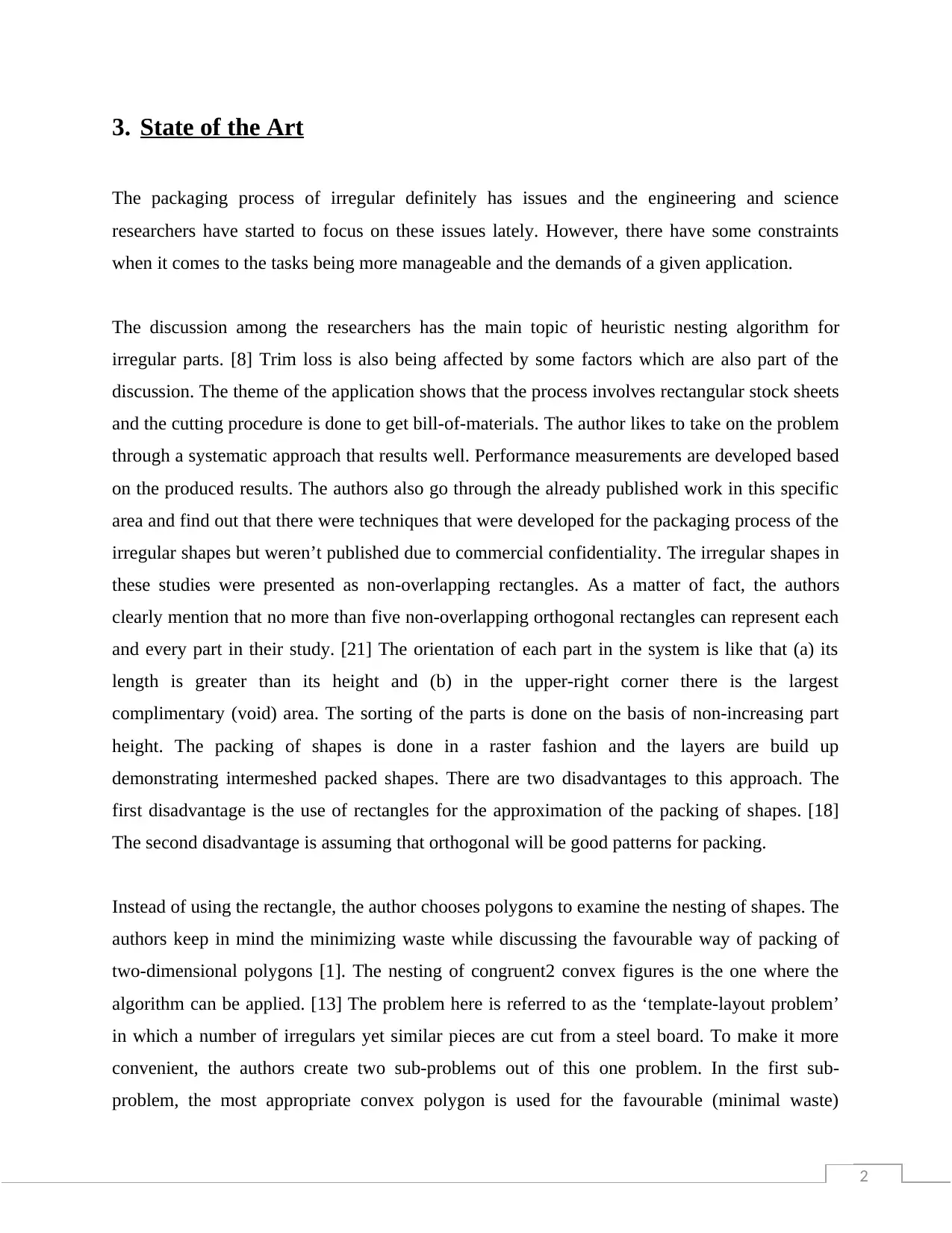
2
3. State of the Art
The packaging process of irregular definitely has issues and the engineering and science
researchers have started to focus on these issues lately. However, there have some constraints
when it comes to the tasks being more manageable and the demands of a given application.
The discussion among the researchers has the main topic of heuristic nesting algorithm for
irregular parts. [8] Trim loss is also being affected by some factors which are also part of the
discussion. The theme of the application shows that the process involves rectangular stock sheets
and the cutting procedure is done to get bill-of-materials. The author likes to take on the problem
through a systematic approach that results well. Performance measurements are developed based
on the produced results. The authors also go through the already published work in this specific
area and find out that there were techniques that were developed for the packaging process of the
irregular shapes but weren’t published due to commercial confidentiality. The irregular shapes in
these studies were presented as non-overlapping rectangles. As a matter of fact, the authors
clearly mention that no more than five non-overlapping orthogonal rectangles can represent each
and every part in their study. [21] The orientation of each part in the system is like that (a) its
length is greater than its height and (b) in the upper-right corner there is the largest
complimentary (void) area. The sorting of the parts is done on the basis of non-increasing part
height. The packing of shapes is done in a raster fashion and the layers are build up
demonstrating intermeshed packed shapes. There are two disadvantages to this approach. The
first disadvantage is the use of rectangles for the approximation of the packing of shapes. [18]
The second disadvantage is assuming that orthogonal will be good patterns for packing.
Instead of using the rectangle, the author chooses polygons to examine the nesting of shapes. The
authors keep in mind the minimizing waste while discussing the favourable way of packing of
two-dimensional polygons [1]. The nesting of congruent2 convex figures is the one where the
algorithm can be applied. [13] The problem here is referred to as the ‘template-layout problem’
in which a number of irregulars yet similar pieces are cut from a steel board. To make it more
convenient, the authors create two sub-problems out of this one problem. In the first sub-
problem, the most appropriate convex polygon is used for the favourable (minimal waste)
3. State of the Art
The packaging process of irregular definitely has issues and the engineering and science
researchers have started to focus on these issues lately. However, there have some constraints
when it comes to the tasks being more manageable and the demands of a given application.
The discussion among the researchers has the main topic of heuristic nesting algorithm for
irregular parts. [8] Trim loss is also being affected by some factors which are also part of the
discussion. The theme of the application shows that the process involves rectangular stock sheets
and the cutting procedure is done to get bill-of-materials. The author likes to take on the problem
through a systematic approach that results well. Performance measurements are developed based
on the produced results. The authors also go through the already published work in this specific
area and find out that there were techniques that were developed for the packaging process of the
irregular shapes but weren’t published due to commercial confidentiality. The irregular shapes in
these studies were presented as non-overlapping rectangles. As a matter of fact, the authors
clearly mention that no more than five non-overlapping orthogonal rectangles can represent each
and every part in their study. [21] The orientation of each part in the system is like that (a) its
length is greater than its height and (b) in the upper-right corner there is the largest
complimentary (void) area. The sorting of the parts is done on the basis of non-increasing part
height. The packing of shapes is done in a raster fashion and the layers are build up
demonstrating intermeshed packed shapes. There are two disadvantages to this approach. The
first disadvantage is the use of rectangles for the approximation of the packing of shapes. [18]
The second disadvantage is assuming that orthogonal will be good patterns for packing.
Instead of using the rectangle, the author chooses polygons to examine the nesting of shapes. The
authors keep in mind the minimizing waste while discussing the favourable way of packing of
two-dimensional polygons [1]. The nesting of congruent2 convex figures is the one where the
algorithm can be applied. [13] The problem here is referred to as the ‘template-layout problem’
in which a number of irregulars yet similar pieces are cut from a steel board. To make it more
convenient, the authors create two sub-problems out of this one problem. In the first sub-
problem, the most appropriate convex polygon is used for the favourable (minimal waste)
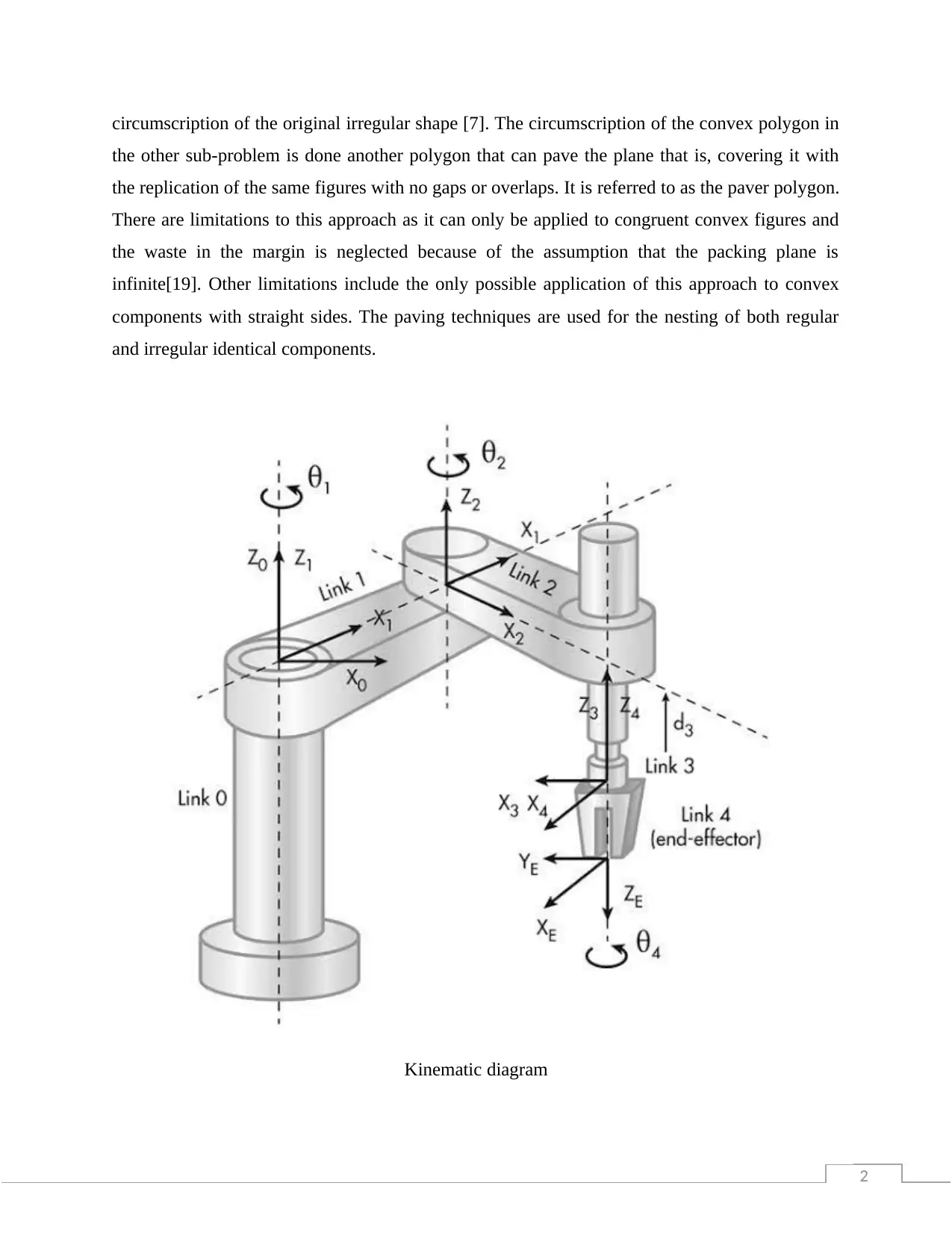
2
circumscription of the original irregular shape [7]. The circumscription of the convex polygon in
the other sub-problem is done another polygon that can pave the plane that is, covering it with
the replication of the same figures with no gaps or overlaps. It is referred to as the paver polygon.
There are limitations to this approach as it can only be applied to congruent convex figures and
the waste in the margin is neglected because of the assumption that the packing plane is
infinite[19]. Other limitations include the only possible application of this approach to convex
components with straight sides. The paving techniques are used for the nesting of both regular
and irregular identical components.
Kinematic diagram
circumscription of the original irregular shape [7]. The circumscription of the convex polygon in
the other sub-problem is done another polygon that can pave the plane that is, covering it with
the replication of the same figures with no gaps or overlaps. It is referred to as the paver polygon.
There are limitations to this approach as it can only be applied to congruent convex figures and
the waste in the margin is neglected because of the assumption that the packing plane is
infinite[19]. Other limitations include the only possible application of this approach to convex
components with straight sides. The paving techniques are used for the nesting of both regular
and irregular identical components.
Kinematic diagram
Paraphrase This Document
Need a fresh take? Get an instant paraphrase of this document with our AI Paraphraser
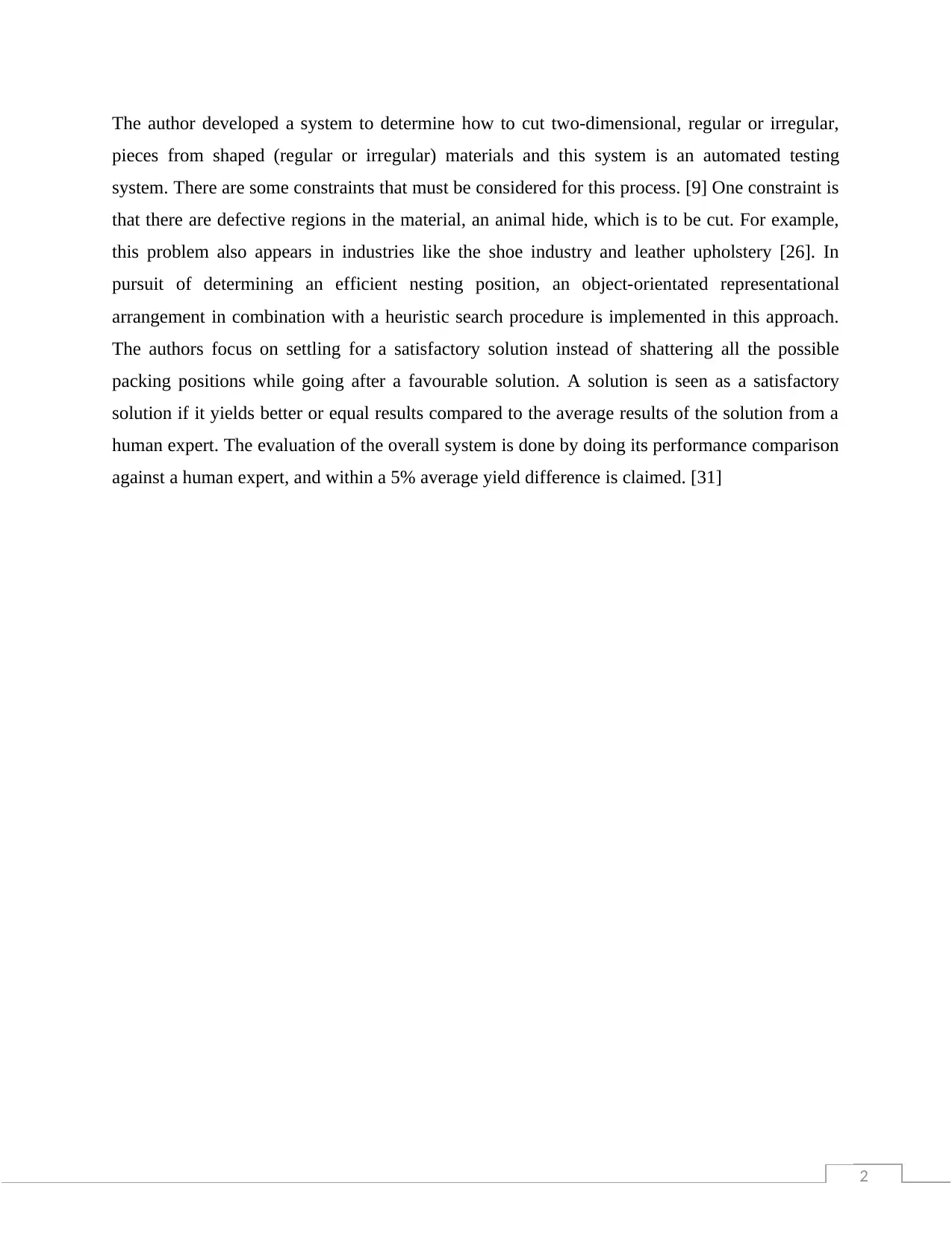
2
The author developed a system to determine how to cut two-dimensional, regular or irregular,
pieces from shaped (regular or irregular) materials and this system is an automated testing
system. There are some constraints that must be considered for this process. [9] One constraint is
that there are defective regions in the material, an animal hide, which is to be cut. For example,
this problem also appears in industries like the shoe industry and leather upholstery [26]. In
pursuit of determining an efficient nesting position, an object-orientated representational
arrangement in combination with a heuristic search procedure is implemented in this approach.
The authors focus on settling for a satisfactory solution instead of shattering all the possible
packing positions while going after a favourable solution. A solution is seen as a satisfactory
solution if it yields better or equal results compared to the average results of the solution from a
human expert. The evaluation of the overall system is done by doing its performance comparison
against a human expert, and within a 5% average yield difference is claimed. [31]
The author developed a system to determine how to cut two-dimensional, regular or irregular,
pieces from shaped (regular or irregular) materials and this system is an automated testing
system. There are some constraints that must be considered for this process. [9] One constraint is
that there are defective regions in the material, an animal hide, which is to be cut. For example,
this problem also appears in industries like the shoe industry and leather upholstery [26]. In
pursuit of determining an efficient nesting position, an object-orientated representational
arrangement in combination with a heuristic search procedure is implemented in this approach.
The authors focus on settling for a satisfactory solution instead of shattering all the possible
packing positions while going after a favourable solution. A solution is seen as a satisfactory
solution if it yields better or equal results compared to the average results of the solution from a
human expert. The evaluation of the overall system is done by doing its performance comparison
against a human expert, and within a 5% average yield difference is claimed. [31]
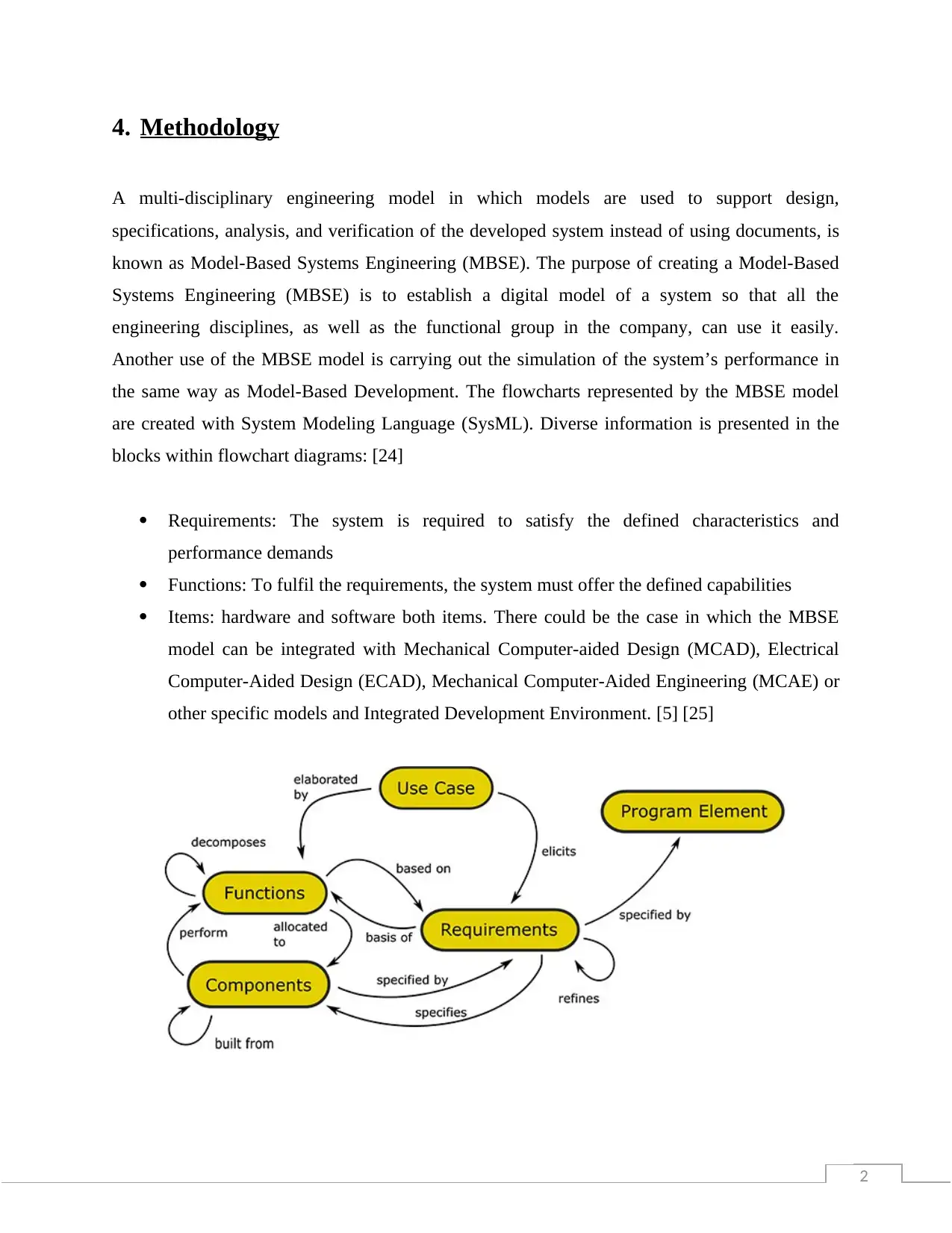
2
4. Methodology
A multi-disciplinary engineering model in which models are used to support design,
specifications, analysis, and verification of the developed system instead of using documents, is
known as Model-Based Systems Engineering (MBSE). The purpose of creating a Model-Based
Systems Engineering (MBSE) is to establish a digital model of a system so that all the
engineering disciplines, as well as the functional group in the company, can use it easily.
Another use of the MBSE model is carrying out the simulation of the system’s performance in
the same way as Model-Based Development. The flowcharts represented by the MBSE model
are created with System Modeling Language (SysML). Diverse information is presented in the
blocks within flowchart diagrams: [24]
Requirements: The system is required to satisfy the defined characteristics and
performance demands
Functions: To fulfil the requirements, the system must offer the defined capabilities
Items: hardware and software both items. There could be the case in which the MBSE
model can be integrated with Mechanical Computer-aided Design (MCAD), Electrical
Computer-Aided Design (ECAD), Mechanical Computer-Aided Engineering (MCAE) or
other specific models and Integrated Development Environment. [5] [25]
4. Methodology
A multi-disciplinary engineering model in which models are used to support design,
specifications, analysis, and verification of the developed system instead of using documents, is
known as Model-Based Systems Engineering (MBSE). The purpose of creating a Model-Based
Systems Engineering (MBSE) is to establish a digital model of a system so that all the
engineering disciplines, as well as the functional group in the company, can use it easily.
Another use of the MBSE model is carrying out the simulation of the system’s performance in
the same way as Model-Based Development. The flowcharts represented by the MBSE model
are created with System Modeling Language (SysML). Diverse information is presented in the
blocks within flowchart diagrams: [24]
Requirements: The system is required to satisfy the defined characteristics and
performance demands
Functions: To fulfil the requirements, the system must offer the defined capabilities
Items: hardware and software both items. There could be the case in which the MBSE
model can be integrated with Mechanical Computer-aided Design (MCAD), Electrical
Computer-Aided Design (ECAD), Mechanical Computer-Aided Engineering (MCAE) or
other specific models and Integrated Development Environment. [5] [25]
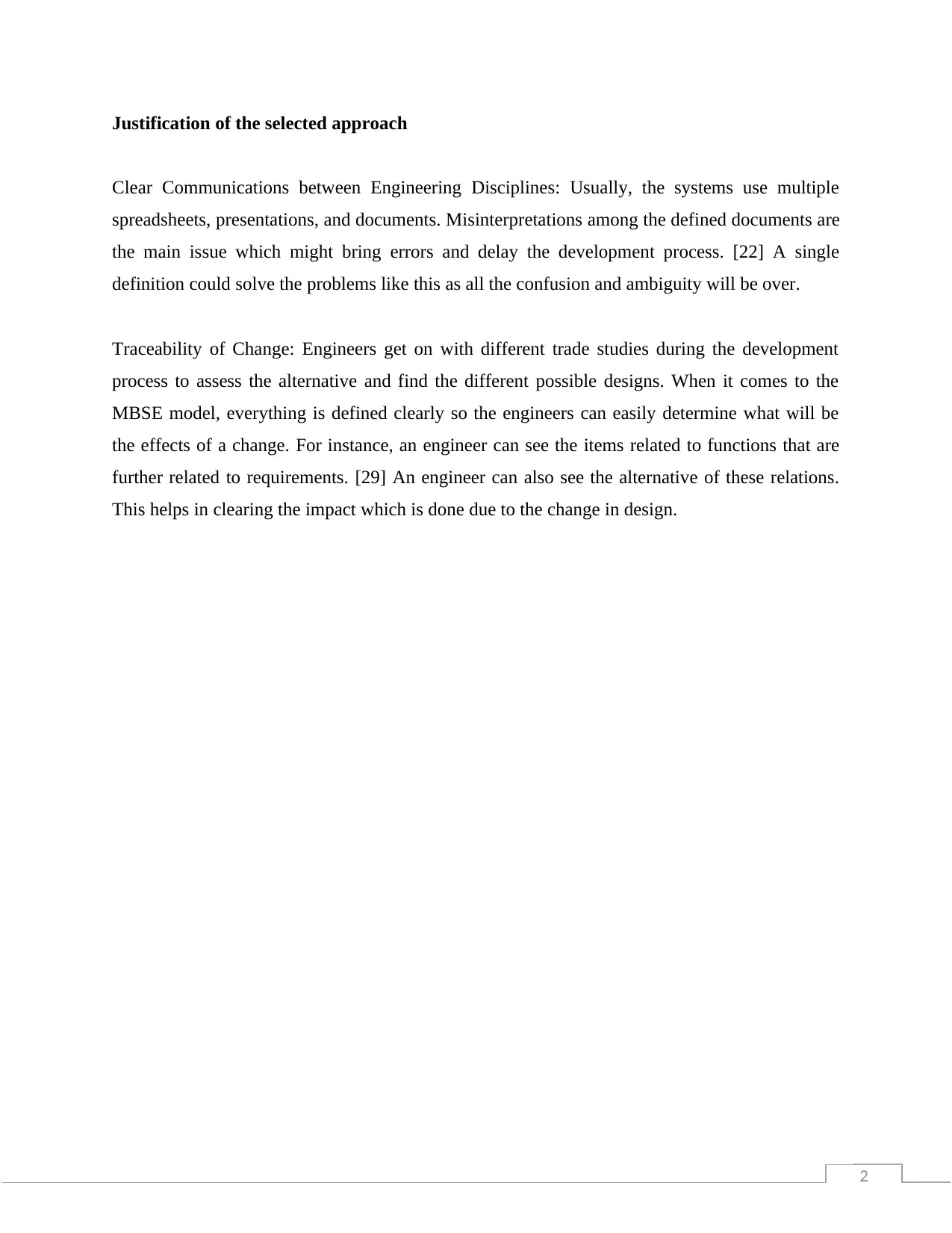
2
Justification of the selected approach
Clear Communications between Engineering Disciplines: Usually, the systems use multiple
spreadsheets, presentations, and documents. Misinterpretations among the defined documents are
the main issue which might bring errors and delay the development process. [22] A single
definition could solve the problems like this as all the confusion and ambiguity will be over.
Traceability of Change: Engineers get on with different trade studies during the development
process to assess the alternative and find the different possible designs. When it comes to the
MBSE model, everything is defined clearly so the engineers can easily determine what will be
the effects of a change. For instance, an engineer can see the items related to functions that are
further related to requirements. [29] An engineer can also see the alternative of these relations.
This helps in clearing the impact which is done due to the change in design.
Justification of the selected approach
Clear Communications between Engineering Disciplines: Usually, the systems use multiple
spreadsheets, presentations, and documents. Misinterpretations among the defined documents are
the main issue which might bring errors and delay the development process. [22] A single
definition could solve the problems like this as all the confusion and ambiguity will be over.
Traceability of Change: Engineers get on with different trade studies during the development
process to assess the alternative and find the different possible designs. When it comes to the
MBSE model, everything is defined clearly so the engineers can easily determine what will be
the effects of a change. For instance, an engineer can see the items related to functions that are
further related to requirements. [29] An engineer can also see the alternative of these relations.
This helps in clearing the impact which is done due to the change in design.
Secure Best Marks with AI Grader
Need help grading? Try our AI Grader for instant feedback on your assignments.
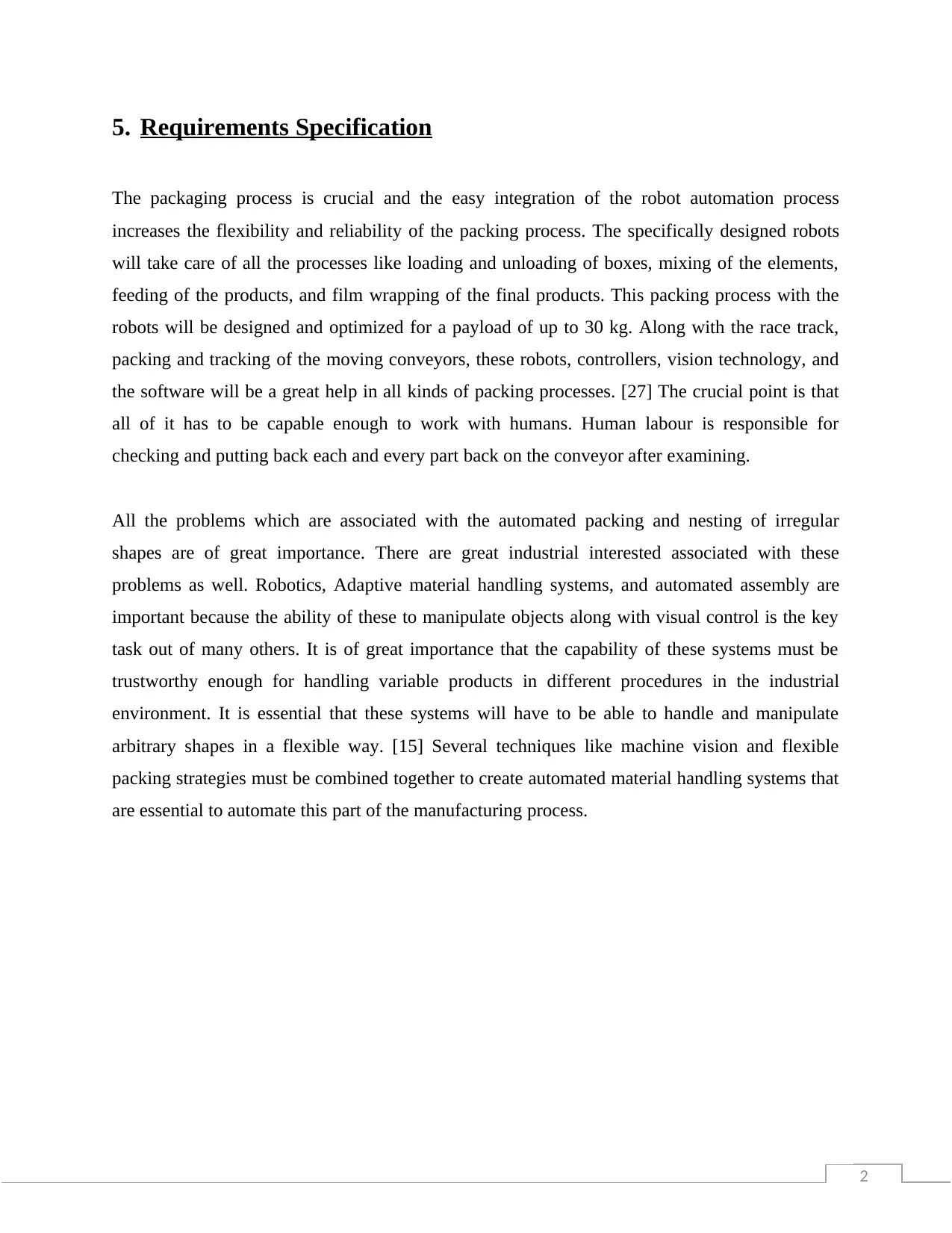
2
5. Requirements Specification
The packaging process is crucial and the easy integration of the robot automation process
increases the flexibility and reliability of the packing process. The specifically designed robots
will take care of all the processes like loading and unloading of boxes, mixing of the elements,
feeding of the products, and film wrapping of the final products. This packing process with the
robots will be designed and optimized for a payload of up to 30 kg. Along with the race track,
packing and tracking of the moving conveyors, these robots, controllers, vision technology, and
the software will be a great help in all kinds of packing processes. [27] The crucial point is that
all of it has to be capable enough to work with humans. Human labour is responsible for
checking and putting back each and every part back on the conveyor after examining.
All the problems which are associated with the automated packing and nesting of irregular
shapes are of great importance. There are great industrial interested associated with these
problems as well. Robotics, Adaptive material handling systems, and automated assembly are
important because the ability of these to manipulate objects along with visual control is the key
task out of many others. It is of great importance that the capability of these systems must be
trustworthy enough for handling variable products in different procedures in the industrial
environment. It is essential that these systems will have to be able to handle and manipulate
arbitrary shapes in a flexible way. [15] Several techniques like machine vision and flexible
packing strategies must be combined together to create automated material handling systems that
are essential to automate this part of the manufacturing process.
5. Requirements Specification
The packaging process is crucial and the easy integration of the robot automation process
increases the flexibility and reliability of the packing process. The specifically designed robots
will take care of all the processes like loading and unloading of boxes, mixing of the elements,
feeding of the products, and film wrapping of the final products. This packing process with the
robots will be designed and optimized for a payload of up to 30 kg. Along with the race track,
packing and tracking of the moving conveyors, these robots, controllers, vision technology, and
the software will be a great help in all kinds of packing processes. [27] The crucial point is that
all of it has to be capable enough to work with humans. Human labour is responsible for
checking and putting back each and every part back on the conveyor after examining.
All the problems which are associated with the automated packing and nesting of irregular
shapes are of great importance. There are great industrial interested associated with these
problems as well. Robotics, Adaptive material handling systems, and automated assembly are
important because the ability of these to manipulate objects along with visual control is the key
task out of many others. It is of great importance that the capability of these systems must be
trustworthy enough for handling variable products in different procedures in the industrial
environment. It is essential that these systems will have to be able to handle and manipulate
arbitrary shapes in a flexible way. [15] Several techniques like machine vision and flexible
packing strategies must be combined together to create automated material handling systems that
are essential to automate this part of the manufacturing process.
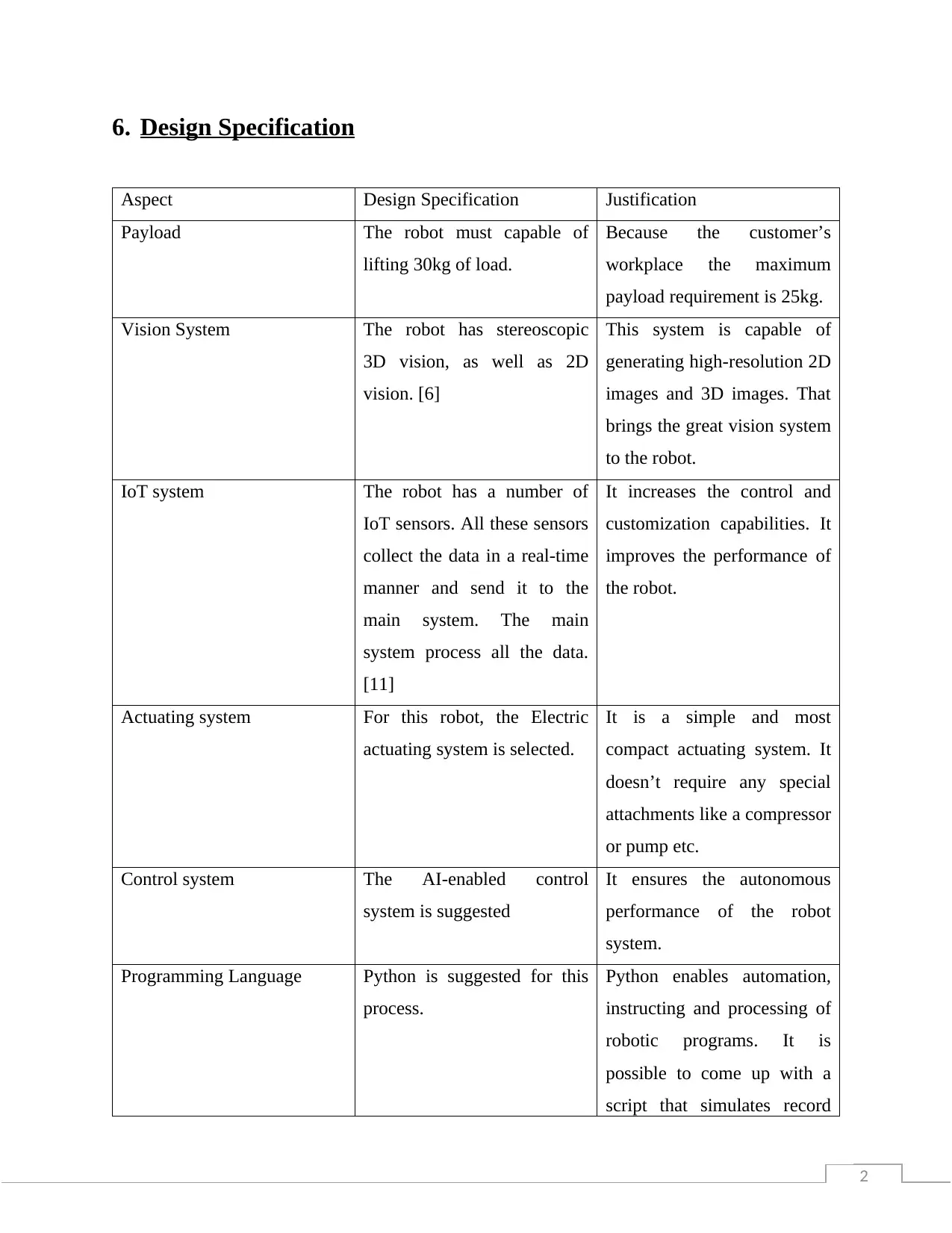
2
6. Design Specification
Aspect Design Specification Justification
Payload The robot must capable of
lifting 30kg of load.
Because the customer’s
workplace the maximum
payload requirement is 25kg.
Vision System The robot has stereoscopic
3D vision, as well as 2D
vision. [6]
This system is capable of
generating high-resolution 2D
images and 3D images. That
brings the great vision system
to the robot.
IoT system The robot has a number of
IoT sensors. All these sensors
collect the data in a real-time
manner and send it to the
main system. The main
system process all the data.
[11]
It increases the control and
customization capabilities. It
improves the performance of
the robot.
Actuating system For this robot, the Electric
actuating system is selected.
It is a simple and most
compact actuating system. It
doesn’t require any special
attachments like a compressor
or pump etc.
Control system The AI-enabled control
system is suggested
It ensures the autonomous
performance of the robot
system.
Programming Language Python is suggested for this
process.
Python enables automation,
instructing and processing of
robotic programs. It is
possible to come up with a
script that simulates record
6. Design Specification
Aspect Design Specification Justification
Payload The robot must capable of
lifting 30kg of load.
Because the customer’s
workplace the maximum
payload requirement is 25kg.
Vision System The robot has stereoscopic
3D vision, as well as 2D
vision. [6]
This system is capable of
generating high-resolution 2D
images and 3D images. That
brings the great vision system
to the robot.
IoT system The robot has a number of
IoT sensors. All these sensors
collect the data in a real-time
manner and send it to the
main system. The main
system process all the data.
[11]
It increases the control and
customization capabilities. It
improves the performance of
the robot.
Actuating system For this robot, the Electric
actuating system is selected.
It is a simple and most
compact actuating system. It
doesn’t require any special
attachments like a compressor
or pump etc.
Control system The AI-enabled control
system is suggested
It ensures the autonomous
performance of the robot
system.
Programming Language Python is suggested for this
process.
Python enables automation,
instructing and processing of
robotic programs. It is
possible to come up with a
script that simulates record

2
and calculate the whole robot
program instead of teaching
robots manually.
and calculate the whole robot
program instead of teaching
robots manually.
Paraphrase This Document
Need a fresh take? Get an instant paraphrase of this document with our AI Paraphraser
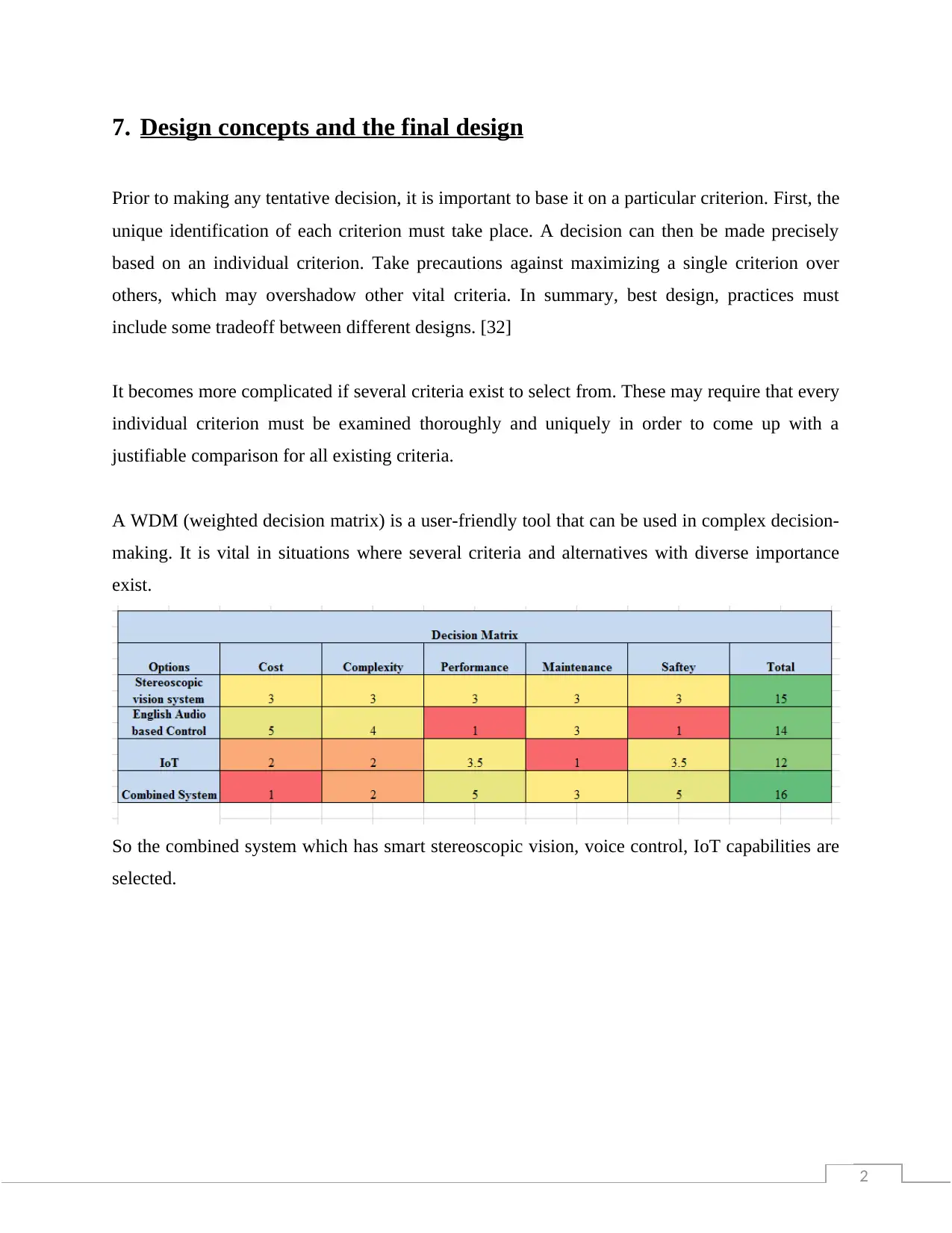
2
7. Design concepts and the final design
Prior to making any tentative decision, it is important to base it on a particular criterion. First, the
unique identification of each criterion must take place. A decision can then be made precisely
based on an individual criterion. Take precautions against maximizing a single criterion over
others, which may overshadow other vital criteria. In summary, best design, practices must
include some tradeoff between different designs. [32]
It becomes more complicated if several criteria exist to select from. These may require that every
individual criterion must be examined thoroughly and uniquely in order to come up with a
justifiable comparison for all existing criteria.
A WDM (weighted decision matrix) is a user-friendly tool that can be used in complex decision-
making. It is vital in situations where several criteria and alternatives with diverse importance
exist.
So the combined system which has smart stereoscopic vision, voice control, IoT capabilities are
selected.
7. Design concepts and the final design
Prior to making any tentative decision, it is important to base it on a particular criterion. First, the
unique identification of each criterion must take place. A decision can then be made precisely
based on an individual criterion. Take precautions against maximizing a single criterion over
others, which may overshadow other vital criteria. In summary, best design, practices must
include some tradeoff between different designs. [32]
It becomes more complicated if several criteria exist to select from. These may require that every
individual criterion must be examined thoroughly and uniquely in order to come up with a
justifiable comparison for all existing criteria.
A WDM (weighted decision matrix) is a user-friendly tool that can be used in complex decision-
making. It is vital in situations where several criteria and alternatives with diverse importance
exist.
So the combined system which has smart stereoscopic vision, voice control, IoT capabilities are
selected.
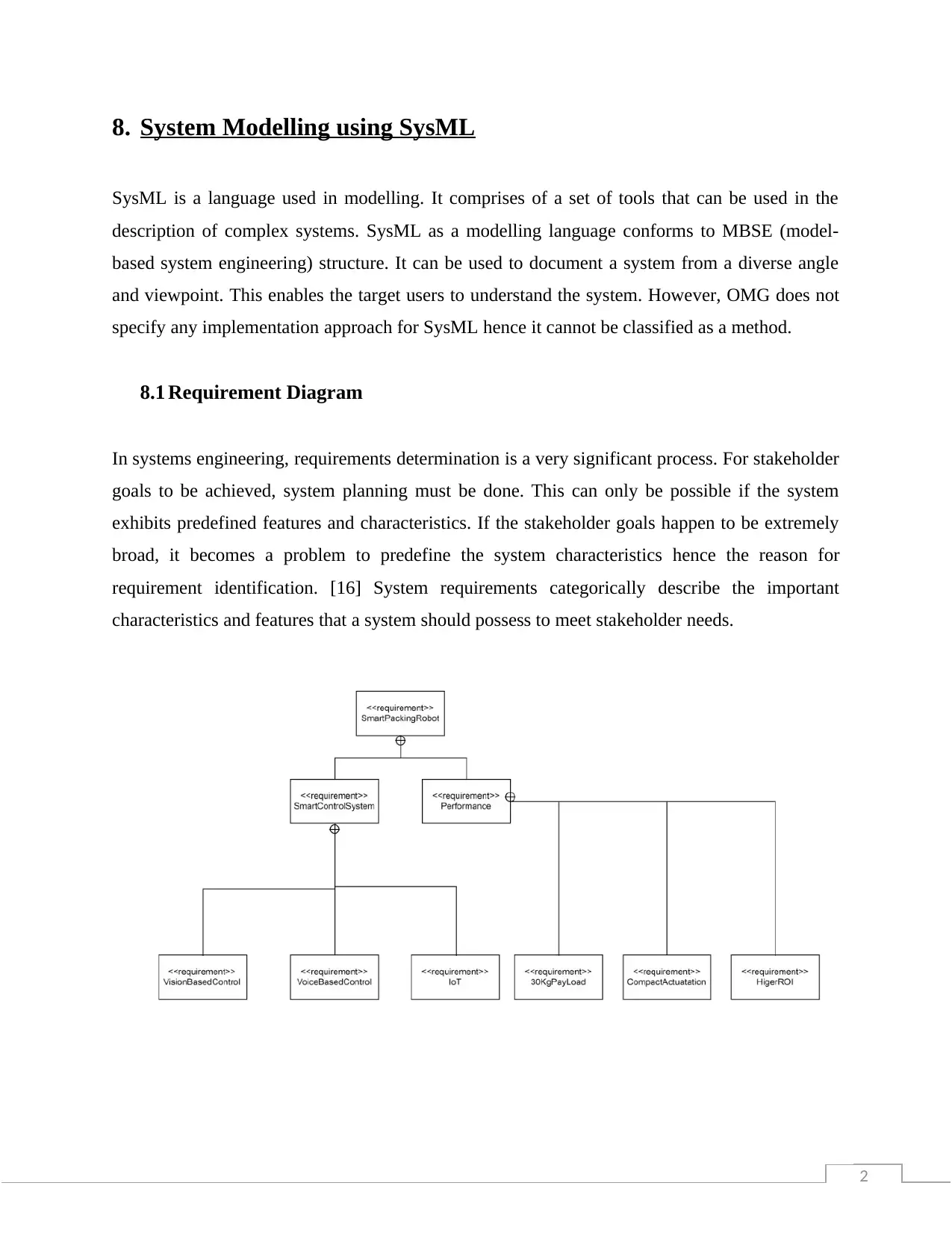
2
8. System Modelling using SysML
SysML is a language used in modelling. It comprises of a set of tools that can be used in the
description of complex systems. SysML as a modelling language conforms to MBSE (model-
based system engineering) structure. It can be used to document a system from a diverse angle
and viewpoint. This enables the target users to understand the system. However, OMG does not
specify any implementation approach for SysML hence it cannot be classified as a method.
8.1 Requirement Diagram
In systems engineering, requirements determination is a very significant process. For stakeholder
goals to be achieved, system planning must be done. This can only be possible if the system
exhibits predefined features and characteristics. If the stakeholder goals happen to be extremely
broad, it becomes a problem to predefine the system characteristics hence the reason for
requirement identification. [16] System requirements categorically describe the important
characteristics and features that a system should possess to meet stakeholder needs.
8. System Modelling using SysML
SysML is a language used in modelling. It comprises of a set of tools that can be used in the
description of complex systems. SysML as a modelling language conforms to MBSE (model-
based system engineering) structure. It can be used to document a system from a diverse angle
and viewpoint. This enables the target users to understand the system. However, OMG does not
specify any implementation approach for SysML hence it cannot be classified as a method.
8.1 Requirement Diagram
In systems engineering, requirements determination is a very significant process. For stakeholder
goals to be achieved, system planning must be done. This can only be possible if the system
exhibits predefined features and characteristics. If the stakeholder goals happen to be extremely
broad, it becomes a problem to predefine the system characteristics hence the reason for
requirement identification. [16] System requirements categorically describe the important
characteristics and features that a system should possess to meet stakeholder needs.
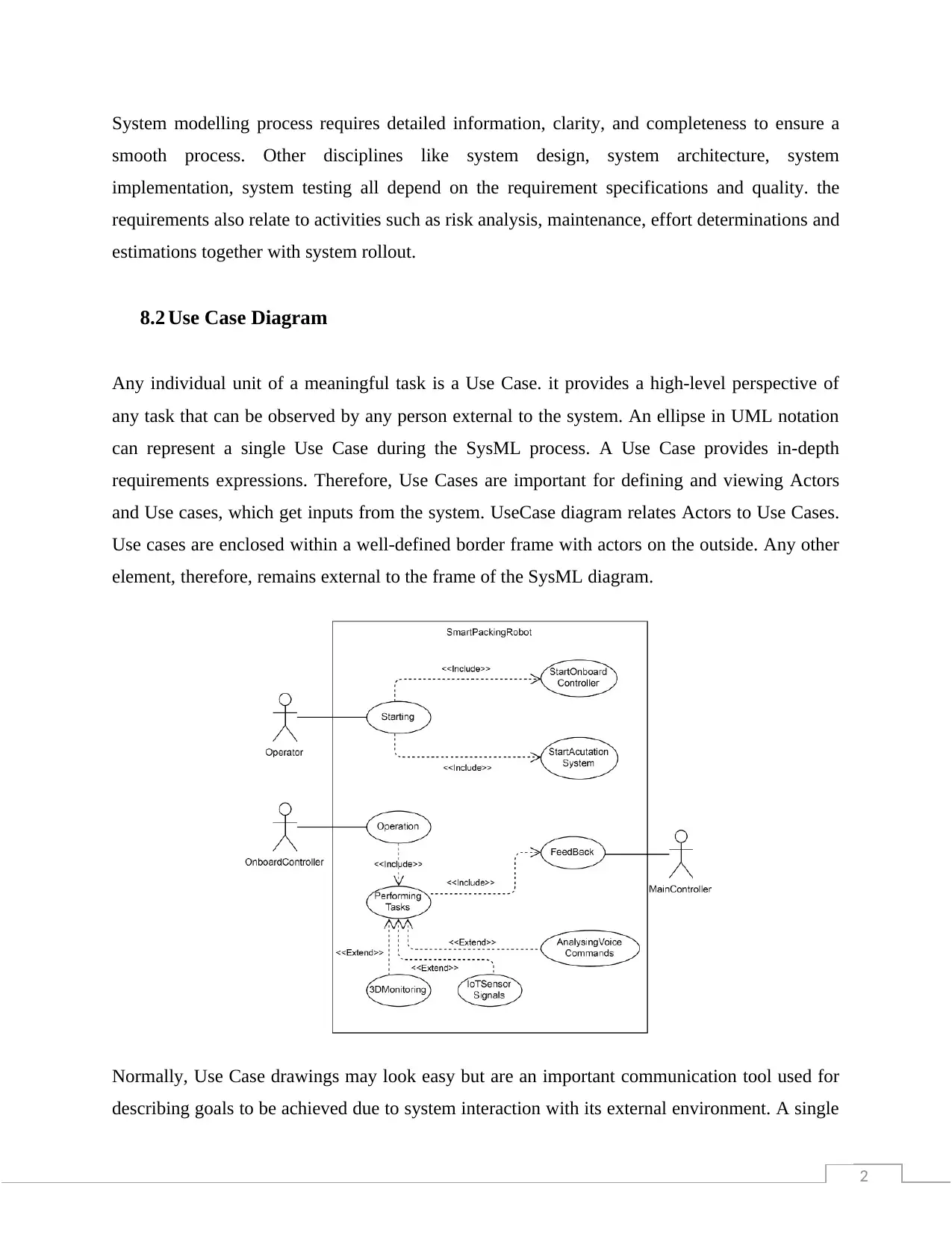
2
System modelling process requires detailed information, clarity, and completeness to ensure a
smooth process. Other disciplines like system design, system architecture, system
implementation, system testing all depend on the requirement specifications and quality. the
requirements also relate to activities such as risk analysis, maintenance, effort determinations and
estimations together with system rollout.
8.2 Use Case Diagram
Any individual unit of a meaningful task is a Use Case. it provides a high-level perspective of
any task that can be observed by any person external to the system. An ellipse in UML notation
can represent a single Use Case during the SysML process. A Use Case provides in-depth
requirements expressions. Therefore, Use Cases are important for defining and viewing Actors
and Use cases, which get inputs from the system. UseCase diagram relates Actors to Use Cases.
Use cases are enclosed within a well-defined border frame with actors on the outside. Any other
element, therefore, remains external to the frame of the SysML diagram.
Normally, Use Case drawings may look easy but are an important communication tool used for
describing goals to be achieved due to system interaction with its external environment. A single
System modelling process requires detailed information, clarity, and completeness to ensure a
smooth process. Other disciplines like system design, system architecture, system
implementation, system testing all depend on the requirement specifications and quality. the
requirements also relate to activities such as risk analysis, maintenance, effort determinations and
estimations together with system rollout.
8.2 Use Case Diagram
Any individual unit of a meaningful task is a Use Case. it provides a high-level perspective of
any task that can be observed by any person external to the system. An ellipse in UML notation
can represent a single Use Case during the SysML process. A Use Case provides in-depth
requirements expressions. Therefore, Use Cases are important for defining and viewing Actors
and Use cases, which get inputs from the system. UseCase diagram relates Actors to Use Cases.
Use cases are enclosed within a well-defined border frame with actors on the outside. Any other
element, therefore, remains external to the frame of the SysML diagram.
Normally, Use Case drawings may look easy but are an important communication tool used for
describing goals to be achieved due to system interaction with its external environment. A single
Secure Best Marks with AI Grader
Need help grading? Try our AI Grader for instant feedback on your assignments.
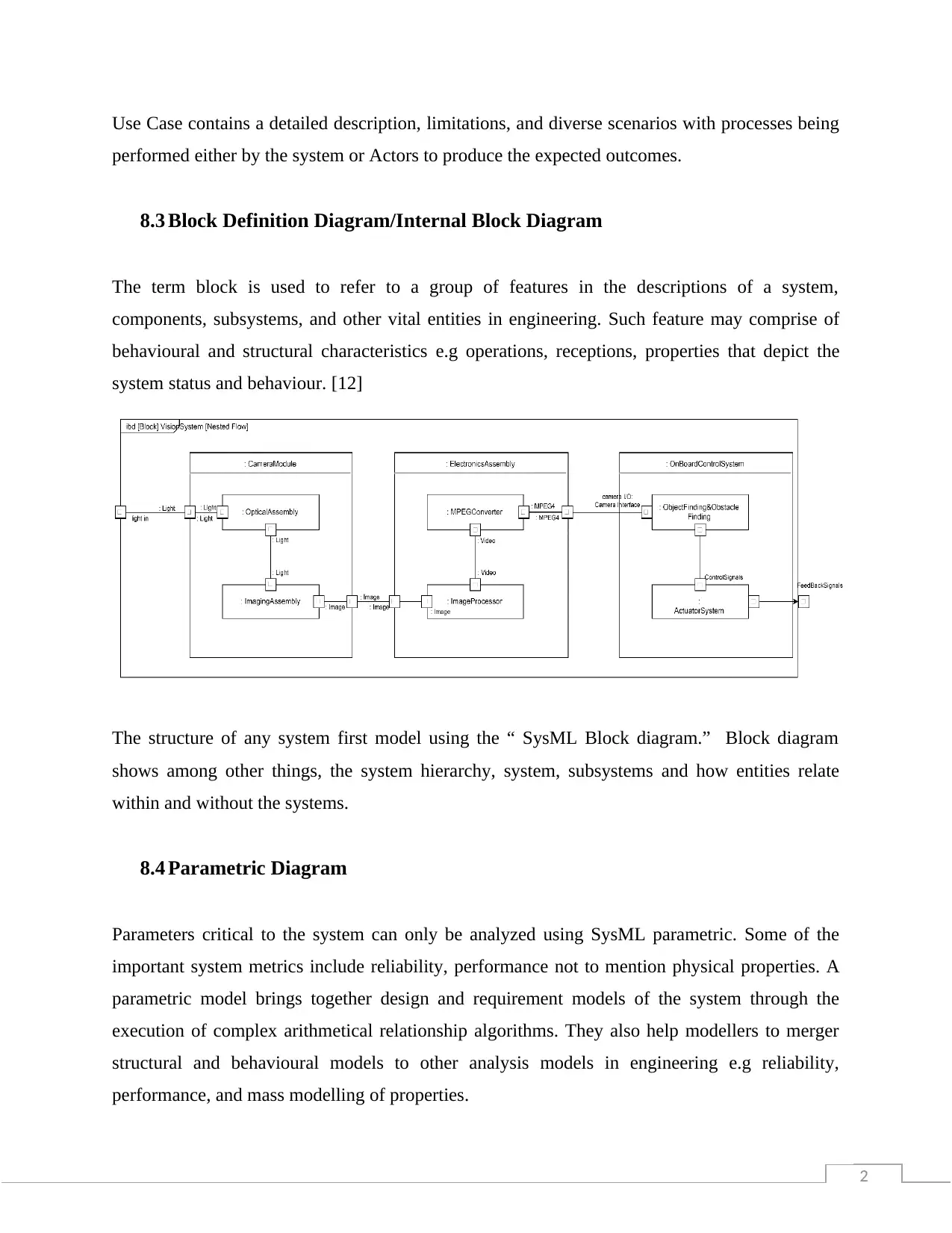
2
Use Case contains a detailed description, limitations, and diverse scenarios with processes being
performed either by the system or Actors to produce the expected outcomes.
8.3 Block Definition Diagram/Internal Block Diagram
The term block is used to refer to a group of features in the descriptions of a system,
components, subsystems, and other vital entities in engineering. Such feature may comprise of
behavioural and structural characteristics e.g operations, receptions, properties that depict the
system status and behaviour. [12]
The structure of any system first model using the “ SysML Block diagram.” Block diagram
shows among other things, the system hierarchy, system, subsystems and how entities relate
within and without the systems.
8.4 Parametric Diagram
Parameters critical to the system can only be analyzed using SysML parametric. Some of the
important system metrics include reliability, performance not to mention physical properties. A
parametric model brings together design and requirement models of the system through the
execution of complex arithmetical relationship algorithms. They also help modellers to merger
structural and behavioural models to other analysis models in engineering e.g reliability,
performance, and mass modelling of properties.
Use Case contains a detailed description, limitations, and diverse scenarios with processes being
performed either by the system or Actors to produce the expected outcomes.
8.3 Block Definition Diagram/Internal Block Diagram
The term block is used to refer to a group of features in the descriptions of a system,
components, subsystems, and other vital entities in engineering. Such feature may comprise of
behavioural and structural characteristics e.g operations, receptions, properties that depict the
system status and behaviour. [12]
The structure of any system first model using the “ SysML Block diagram.” Block diagram
shows among other things, the system hierarchy, system, subsystems and how entities relate
within and without the systems.
8.4 Parametric Diagram
Parameters critical to the system can only be analyzed using SysML parametric. Some of the
important system metrics include reliability, performance not to mention physical properties. A
parametric model brings together design and requirement models of the system through the
execution of complex arithmetical relationship algorithms. They also help modellers to merger
structural and behavioural models to other analysis models in engineering e.g reliability,
performance, and mass modelling of properties.
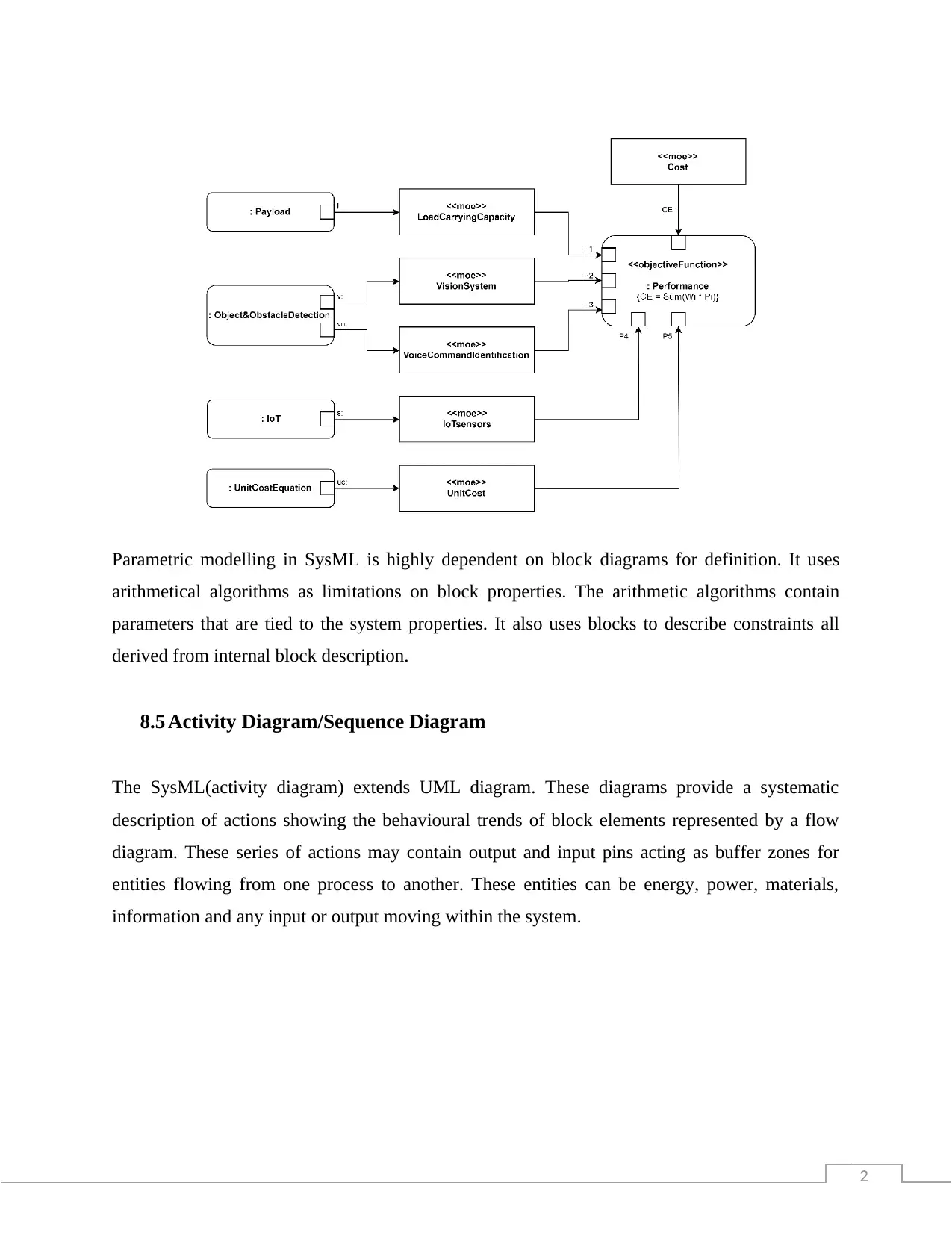
2
Parametric modelling in SysML is highly dependent on block diagrams for definition. It uses
arithmetical algorithms as limitations on block properties. The arithmetic algorithms contain
parameters that are tied to the system properties. It also uses blocks to describe constraints all
derived from internal block description.
8.5 Activity Diagram/Sequence Diagram
The SysML(activity diagram) extends UML diagram. These diagrams provide a systematic
description of actions showing the behavioural trends of block elements represented by a flow
diagram. These series of actions may contain output and input pins acting as buffer zones for
entities flowing from one process to another. These entities can be energy, power, materials,
information and any input or output moving within the system.
Parametric modelling in SysML is highly dependent on block diagrams for definition. It uses
arithmetical algorithms as limitations on block properties. The arithmetic algorithms contain
parameters that are tied to the system properties. It also uses blocks to describe constraints all
derived from internal block description.
8.5 Activity Diagram/Sequence Diagram
The SysML(activity diagram) extends UML diagram. These diagrams provide a systematic
description of actions showing the behavioural trends of block elements represented by a flow
diagram. These series of actions may contain output and input pins acting as buffer zones for
entities flowing from one process to another. These entities can be energy, power, materials,
information and any input or output moving within the system.
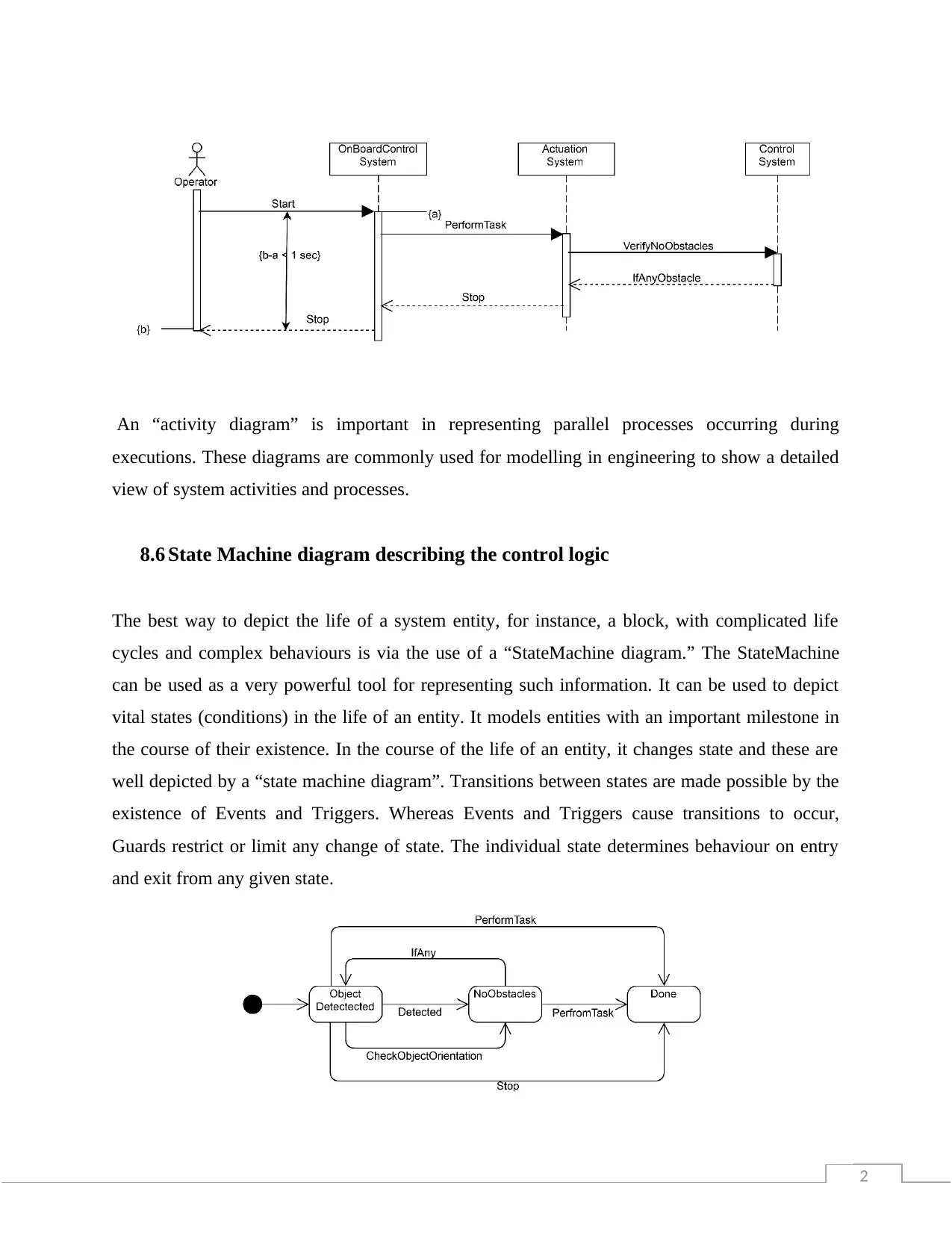
2
An “activity diagram” is important in representing parallel processes occurring during
executions. These diagrams are commonly used for modelling in engineering to show a detailed
view of system activities and processes.
8.6 State Machine diagram describing the control logic
The best way to depict the life of a system entity, for instance, a block, with complicated life
cycles and complex behaviours is via the use of a “StateMachine diagram.” The StateMachine
can be used as a very powerful tool for representing such information. It can be used to depict
vital states (conditions) in the life of an entity. It models entities with an important milestone in
the course of their existence. In the course of the life of an entity, it changes state and these are
well depicted by a “state machine diagram”. Transitions between states are made possible by the
existence of Events and Triggers. Whereas Events and Triggers cause transitions to occur,
Guards restrict or limit any change of state. The individual state determines behaviour on entry
and exit from any given state.
An “activity diagram” is important in representing parallel processes occurring during
executions. These diagrams are commonly used for modelling in engineering to show a detailed
view of system activities and processes.
8.6 State Machine diagram describing the control logic
The best way to depict the life of a system entity, for instance, a block, with complicated life
cycles and complex behaviours is via the use of a “StateMachine diagram.” The StateMachine
can be used as a very powerful tool for representing such information. It can be used to depict
vital states (conditions) in the life of an entity. It models entities with an important milestone in
the course of their existence. In the course of the life of an entity, it changes state and these are
well depicted by a “state machine diagram”. Transitions between states are made possible by the
existence of Events and Triggers. Whereas Events and Triggers cause transitions to occur,
Guards restrict or limit any change of state. The individual state determines behaviour on entry
and exit from any given state.
Paraphrase This Document
Need a fresh take? Get an instant paraphrase of this document with our AI Paraphraser
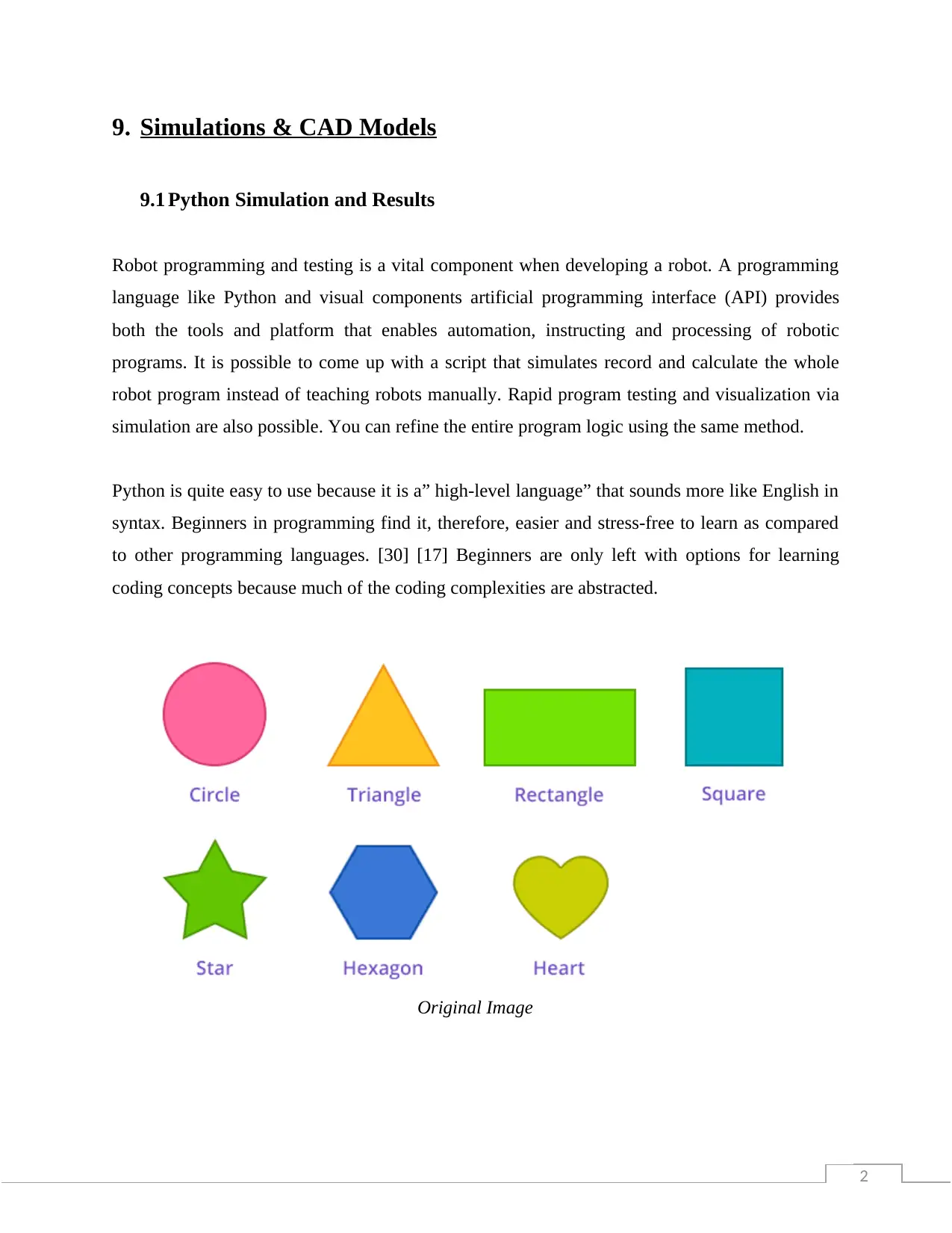
2
9. Simulations & CAD Models
9.1 Python Simulation and Results
Robot programming and testing is a vital component when developing a robot. A programming
language like Python and visual components artificial programming interface (API) provides
both the tools and platform that enables automation, instructing and processing of robotic
programs. It is possible to come up with a script that simulates record and calculate the whole
robot program instead of teaching robots manually. Rapid program testing and visualization via
simulation are also possible. You can refine the entire program logic using the same method.
Python is quite easy to use because it is a” high-level language” that sounds more like English in
syntax. Beginners in programming find it, therefore, easier and stress-free to learn as compared
to other programming languages. [30] [17] Beginners are only left with options for learning
coding concepts because much of the coding complexities are abstracted.
Original Image
9. Simulations & CAD Models
9.1 Python Simulation and Results
Robot programming and testing is a vital component when developing a robot. A programming
language like Python and visual components artificial programming interface (API) provides
both the tools and platform that enables automation, instructing and processing of robotic
programs. It is possible to come up with a script that simulates record and calculate the whole
robot program instead of teaching robots manually. Rapid program testing and visualization via
simulation are also possible. You can refine the entire program logic using the same method.
Python is quite easy to use because it is a” high-level language” that sounds more like English in
syntax. Beginners in programming find it, therefore, easier and stress-free to learn as compared
to other programming languages. [30] [17] Beginners are only left with options for learning
coding concepts because much of the coding complexities are abstracted.
Original Image
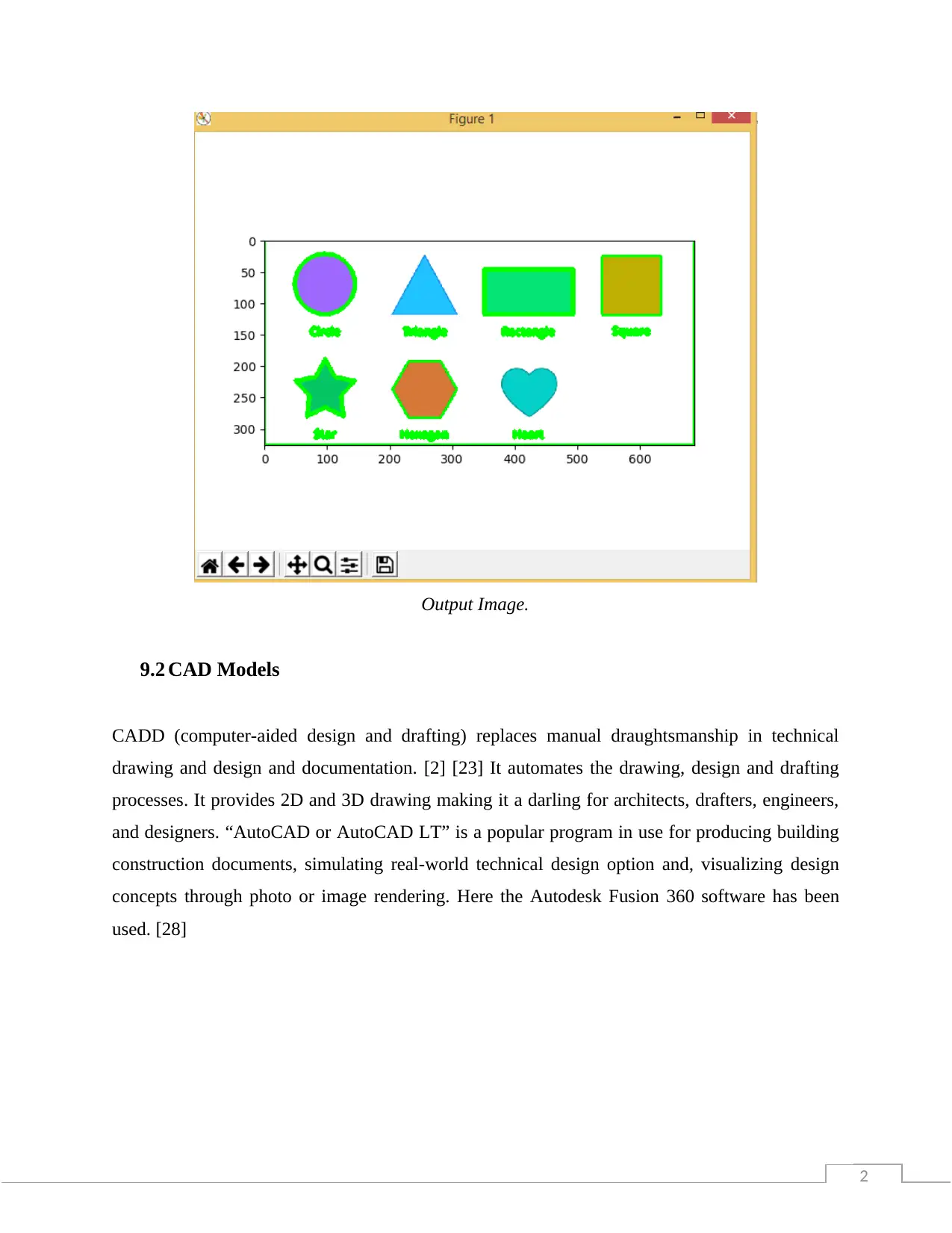
2
Output Image.
9.2 CAD Models
CADD (computer-aided design and drafting) replaces manual draughtsmanship in technical
drawing and design and documentation. [2] [23] It automates the drawing, design and drafting
processes. It provides 2D and 3D drawing making it a darling for architects, drafters, engineers,
and designers. “AutoCAD or AutoCAD LT” is a popular program in use for producing building
construction documents, simulating real-world technical design option and, visualizing design
concepts through photo or image rendering. Here the Autodesk Fusion 360 software has been
used. [28]
Output Image.
9.2 CAD Models
CADD (computer-aided design and drafting) replaces manual draughtsmanship in technical
drawing and design and documentation. [2] [23] It automates the drawing, design and drafting
processes. It provides 2D and 3D drawing making it a darling for architects, drafters, engineers,
and designers. “AutoCAD or AutoCAD LT” is a popular program in use for producing building
construction documents, simulating real-world technical design option and, visualizing design
concepts through photo or image rendering. Here the Autodesk Fusion 360 software has been
used. [28]
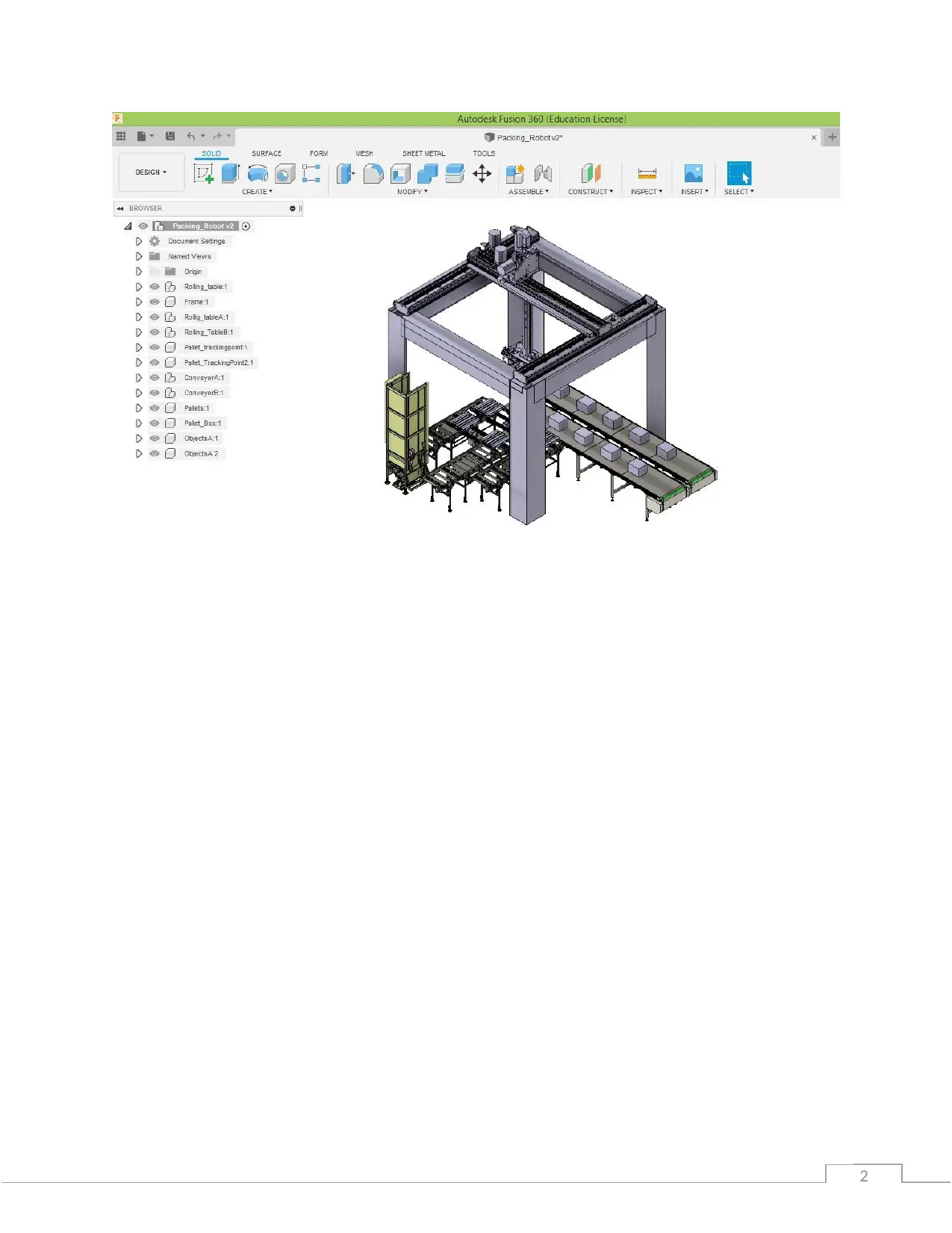
2
Secure Best Marks with AI Grader
Need help grading? Try our AI Grader for instant feedback on your assignments.
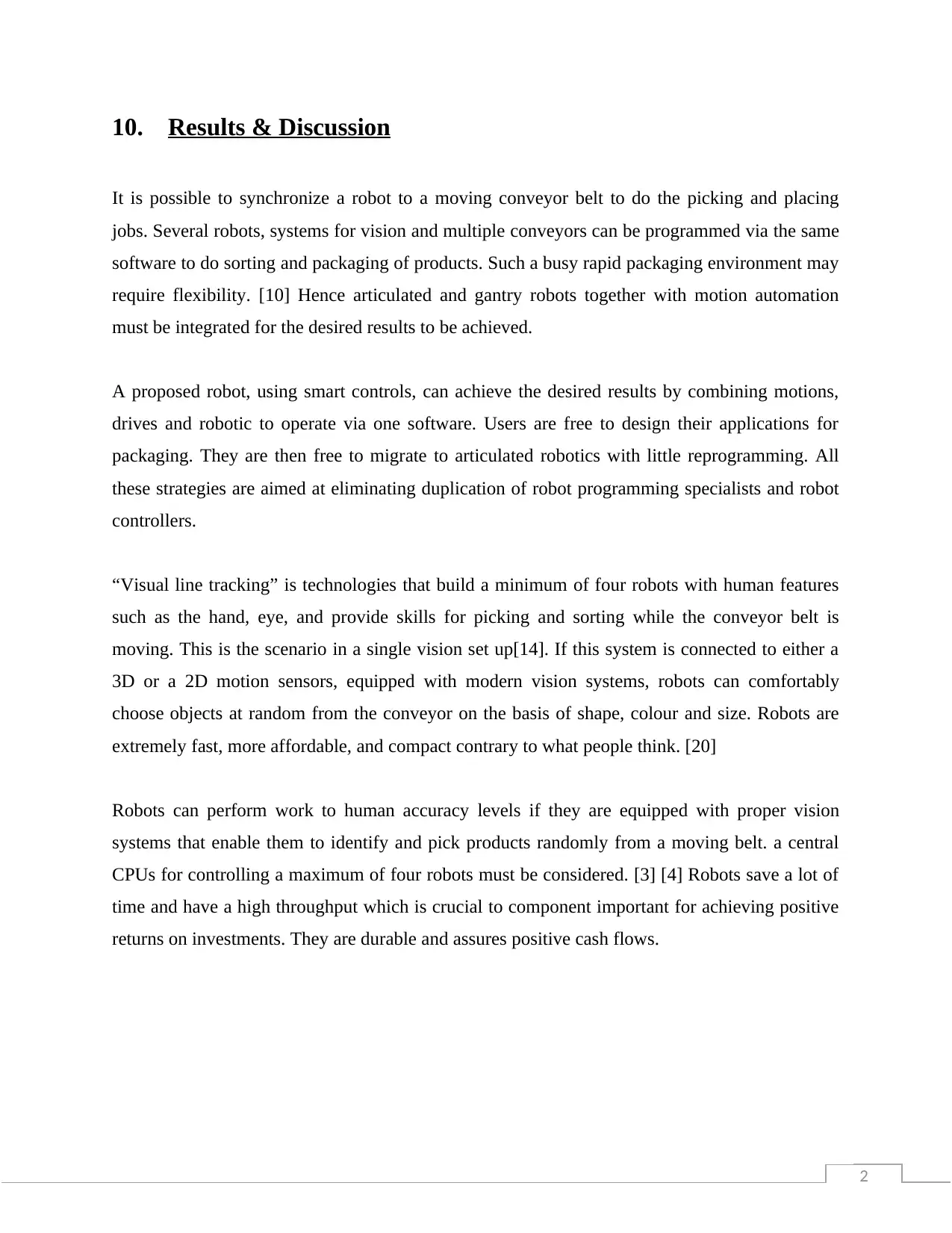
2
10. Results & Discussion
It is possible to synchronize a robot to a moving conveyor belt to do the picking and placing
jobs. Several robots, systems for vision and multiple conveyors can be programmed via the same
software to do sorting and packaging of products. Such a busy rapid packaging environment may
require flexibility. [10] Hence articulated and gantry robots together with motion automation
must be integrated for the desired results to be achieved.
A proposed robot, using smart controls, can achieve the desired results by combining motions,
drives and robotic to operate via one software. Users are free to design their applications for
packaging. They are then free to migrate to articulated robotics with little reprogramming. All
these strategies are aimed at eliminating duplication of robot programming specialists and robot
controllers.
“Visual line tracking” is technologies that build a minimum of four robots with human features
such as the hand, eye, and provide skills for picking and sorting while the conveyor belt is
moving. This is the scenario in a single vision set up[14]. If this system is connected to either a
3D or a 2D motion sensors, equipped with modern vision systems, robots can comfortably
choose objects at random from the conveyor on the basis of shape, colour and size. Robots are
extremely fast, more affordable, and compact contrary to what people think. [20]
Robots can perform work to human accuracy levels if they are equipped with proper vision
systems that enable them to identify and pick products randomly from a moving belt. a central
CPUs for controlling a maximum of four robots must be considered. [3] [4] Robots save a lot of
time and have a high throughput which is crucial to component important for achieving positive
returns on investments. They are durable and assures positive cash flows.
10. Results & Discussion
It is possible to synchronize a robot to a moving conveyor belt to do the picking and placing
jobs. Several robots, systems for vision and multiple conveyors can be programmed via the same
software to do sorting and packaging of products. Such a busy rapid packaging environment may
require flexibility. [10] Hence articulated and gantry robots together with motion automation
must be integrated for the desired results to be achieved.
A proposed robot, using smart controls, can achieve the desired results by combining motions,
drives and robotic to operate via one software. Users are free to design their applications for
packaging. They are then free to migrate to articulated robotics with little reprogramming. All
these strategies are aimed at eliminating duplication of robot programming specialists and robot
controllers.
“Visual line tracking” is technologies that build a minimum of four robots with human features
such as the hand, eye, and provide skills for picking and sorting while the conveyor belt is
moving. This is the scenario in a single vision set up[14]. If this system is connected to either a
3D or a 2D motion sensors, equipped with modern vision systems, robots can comfortably
choose objects at random from the conveyor on the basis of shape, colour and size. Robots are
extremely fast, more affordable, and compact contrary to what people think. [20]
Robots can perform work to human accuracy levels if they are equipped with proper vision
systems that enable them to identify and pick products randomly from a moving belt. a central
CPUs for controlling a maximum of four robots must be considered. [3] [4] Robots save a lot of
time and have a high throughput which is crucial to component important for achieving positive
returns on investments. They are durable and assures positive cash flows.
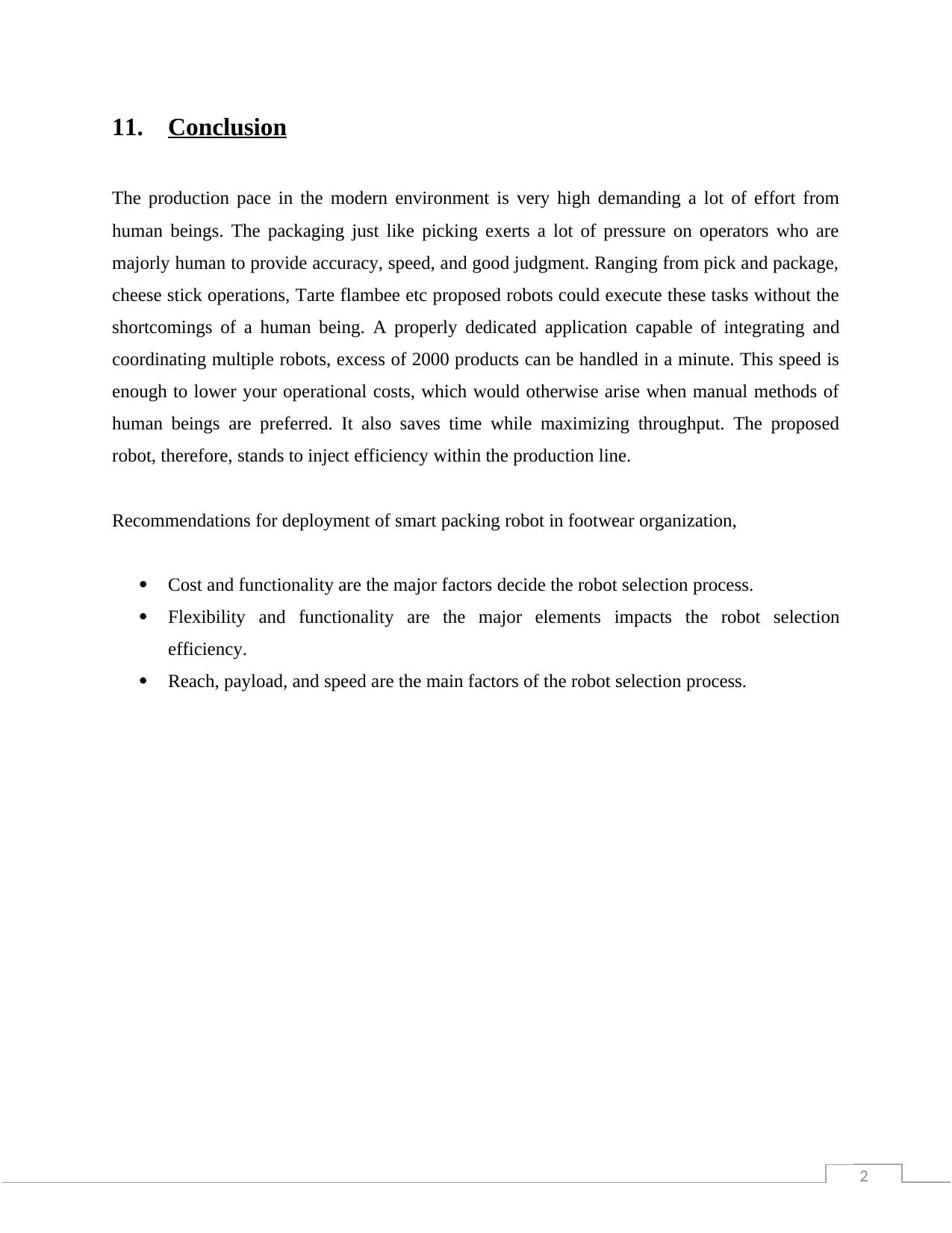
2
11. Conclusion
The production pace in the modern environment is very high demanding a lot of effort from
human beings. The packaging just like picking exerts a lot of pressure on operators who are
majorly human to provide accuracy, speed, and good judgment. Ranging from pick and package,
cheese stick operations, Tarte flambee etc proposed robots could execute these tasks without the
shortcomings of a human being. A properly dedicated application capable of integrating and
coordinating multiple robots, excess of 2000 products can be handled in a minute. This speed is
enough to lower your operational costs, which would otherwise arise when manual methods of
human beings are preferred. It also saves time while maximizing throughput. The proposed
robot, therefore, stands to inject efficiency within the production line.
Recommendations for deployment of smart packing robot in footwear organization,
Cost and functionality are the major factors decide the robot selection process.
Flexibility and functionality are the major elements impacts the robot selection
efficiency.
Reach, payload, and speed are the main factors of the robot selection process.
11. Conclusion
The production pace in the modern environment is very high demanding a lot of effort from
human beings. The packaging just like picking exerts a lot of pressure on operators who are
majorly human to provide accuracy, speed, and good judgment. Ranging from pick and package,
cheese stick operations, Tarte flambee etc proposed robots could execute these tasks without the
shortcomings of a human being. A properly dedicated application capable of integrating and
coordinating multiple robots, excess of 2000 products can be handled in a minute. This speed is
enough to lower your operational costs, which would otherwise arise when manual methods of
human beings are preferred. It also saves time while maximizing throughput. The proposed
robot, therefore, stands to inject efficiency within the production line.
Recommendations for deployment of smart packing robot in footwear organization,
Cost and functionality are the major factors decide the robot selection process.
Flexibility and functionality are the major elements impacts the robot selection
efficiency.
Reach, payload, and speed are the main factors of the robot selection process.
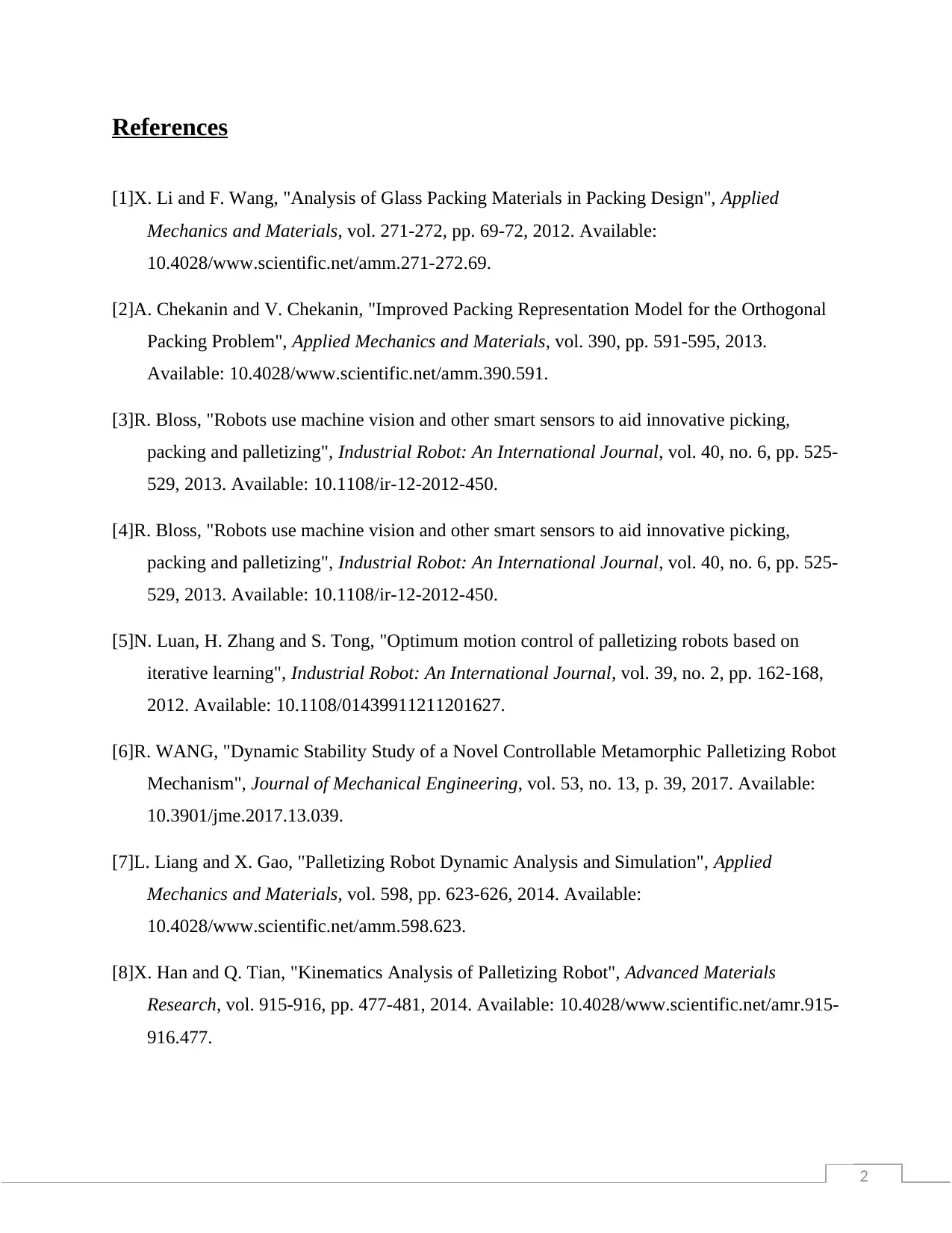
2
References
[1]X. Li and F. Wang, "Analysis of Glass Packing Materials in Packing Design", Applied
Mechanics and Materials, vol. 271-272, pp. 69-72, 2012. Available:
10.4028/www.scientific.net/amm.271-272.69.
[2]A. Chekanin and V. Chekanin, "Improved Packing Representation Model for the Orthogonal
Packing Problem", Applied Mechanics and Materials, vol. 390, pp. 591-595, 2013.
Available: 10.4028/www.scientific.net/amm.390.591.
[3]R. Bloss, "Robots use machine vision and other smart sensors to aid innovative picking,
packing and palletizing", Industrial Robot: An International Journal, vol. 40, no. 6, pp. 525-
529, 2013. Available: 10.1108/ir-12-2012-450.
[4]R. Bloss, "Robots use machine vision and other smart sensors to aid innovative picking,
packing and palletizing", Industrial Robot: An International Journal, vol. 40, no. 6, pp. 525-
529, 2013. Available: 10.1108/ir-12-2012-450.
[5]N. Luan, H. Zhang and S. Tong, "Optimum motion control of palletizing robots based on
iterative learning", Industrial Robot: An International Journal, vol. 39, no. 2, pp. 162-168,
2012. Available: 10.1108/01439911211201627.
[6]R. WANG, "Dynamic Stability Study of a Novel Controllable Metamorphic Palletizing Robot
Mechanism", Journal of Mechanical Engineering, vol. 53, no. 13, p. 39, 2017. Available:
10.3901/jme.2017.13.039.
[7]L. Liang and X. Gao, "Palletizing Robot Dynamic Analysis and Simulation", Applied
Mechanics and Materials, vol. 598, pp. 623-626, 2014. Available:
10.4028/www.scientific.net/amm.598.623.
[8]X. Han and Q. Tian, "Kinematics Analysis of Palletizing Robot", Advanced Materials
Research, vol. 915-916, pp. 477-481, 2014. Available: 10.4028/www.scientific.net/amr.915-
916.477.
References
[1]X. Li and F. Wang, "Analysis of Glass Packing Materials in Packing Design", Applied
Mechanics and Materials, vol. 271-272, pp. 69-72, 2012. Available:
10.4028/www.scientific.net/amm.271-272.69.
[2]A. Chekanin and V. Chekanin, "Improved Packing Representation Model for the Orthogonal
Packing Problem", Applied Mechanics and Materials, vol. 390, pp. 591-595, 2013.
Available: 10.4028/www.scientific.net/amm.390.591.
[3]R. Bloss, "Robots use machine vision and other smart sensors to aid innovative picking,
packing and palletizing", Industrial Robot: An International Journal, vol. 40, no. 6, pp. 525-
529, 2013. Available: 10.1108/ir-12-2012-450.
[4]R. Bloss, "Robots use machine vision and other smart sensors to aid innovative picking,
packing and palletizing", Industrial Robot: An International Journal, vol. 40, no. 6, pp. 525-
529, 2013. Available: 10.1108/ir-12-2012-450.
[5]N. Luan, H. Zhang and S. Tong, "Optimum motion control of palletizing robots based on
iterative learning", Industrial Robot: An International Journal, vol. 39, no. 2, pp. 162-168,
2012. Available: 10.1108/01439911211201627.
[6]R. WANG, "Dynamic Stability Study of a Novel Controllable Metamorphic Palletizing Robot
Mechanism", Journal of Mechanical Engineering, vol. 53, no. 13, p. 39, 2017. Available:
10.3901/jme.2017.13.039.
[7]L. Liang and X. Gao, "Palletizing Robot Dynamic Analysis and Simulation", Applied
Mechanics and Materials, vol. 598, pp. 623-626, 2014. Available:
10.4028/www.scientific.net/amm.598.623.
[8]X. Han and Q. Tian, "Kinematics Analysis of Palletizing Robot", Advanced Materials
Research, vol. 915-916, pp. 477-481, 2014. Available: 10.4028/www.scientific.net/amr.915-
916.477.
Paraphrase This Document
Need a fresh take? Get an instant paraphrase of this document with our AI Paraphraser
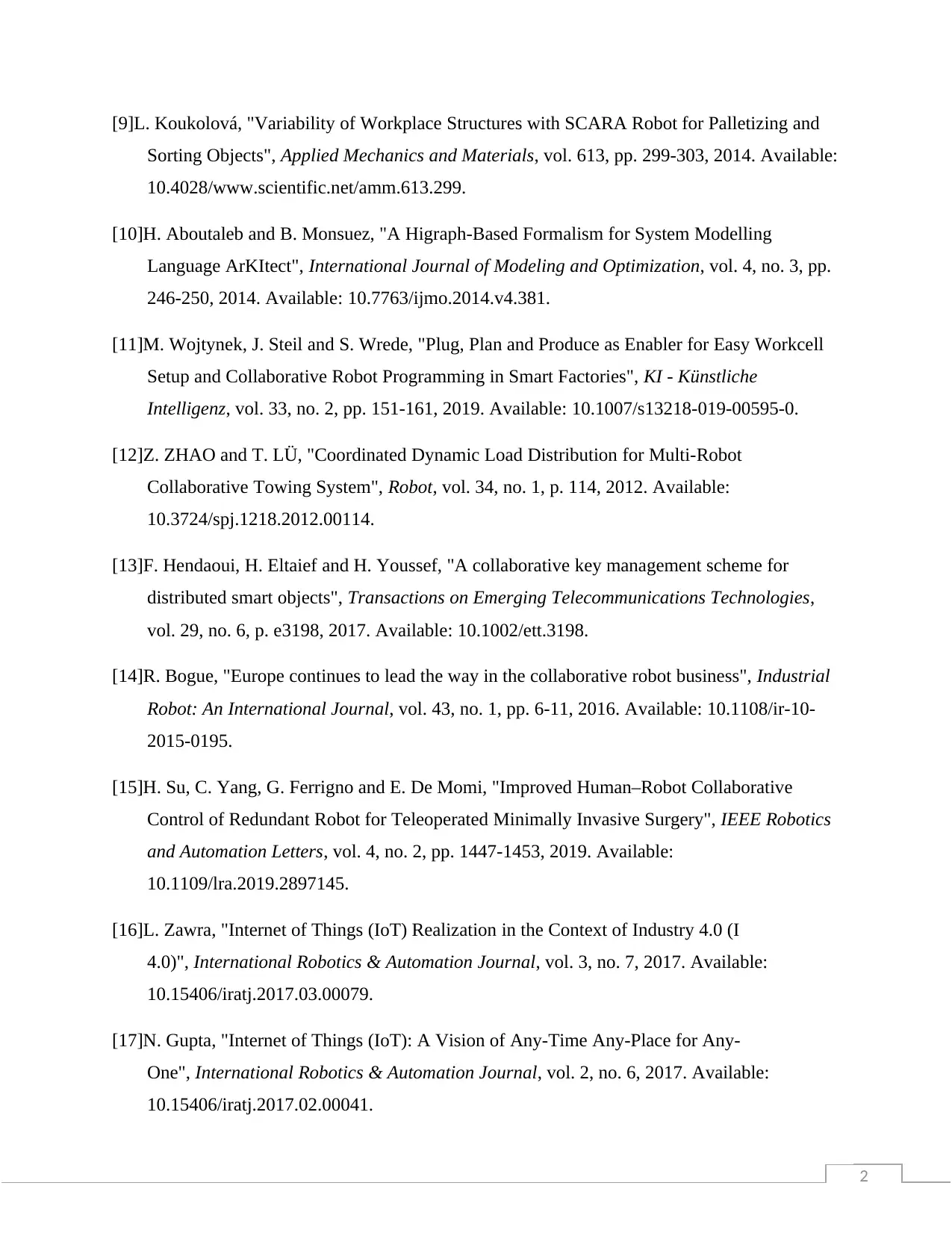
2
[9]L. Koukolová, "Variability of Workplace Structures with SCARA Robot for Palletizing and
Sorting Objects", Applied Mechanics and Materials, vol. 613, pp. 299-303, 2014. Available:
10.4028/www.scientific.net/amm.613.299.
[10]H. Aboutaleb and B. Monsuez, "A Higraph-Based Formalism for System Modelling
Language ArKItect", International Journal of Modeling and Optimization, vol. 4, no. 3, pp.
246-250, 2014. Available: 10.7763/ijmo.2014.v4.381.
[11]M. Wojtynek, J. Steil and S. Wrede, "Plug, Plan and Produce as Enabler for Easy Workcell
Setup and Collaborative Robot Programming in Smart Factories", KI - Künstliche
Intelligenz, vol. 33, no. 2, pp. 151-161, 2019. Available: 10.1007/s13218-019-00595-0.
[12]Z. ZHAO and T. LÜ, "Coordinated Dynamic Load Distribution for Multi-Robot
Collaborative Towing System", Robot, vol. 34, no. 1, p. 114, 2012. Available:
10.3724/spj.1218.2012.00114.
[13]F. Hendaoui, H. Eltaief and H. Youssef, "A collaborative key management scheme for
distributed smart objects", Transactions on Emerging Telecommunications Technologies,
vol. 29, no. 6, p. e3198, 2017. Available: 10.1002/ett.3198.
[14]R. Bogue, "Europe continues to lead the way in the collaborative robot business", Industrial
Robot: An International Journal, vol. 43, no. 1, pp. 6-11, 2016. Available: 10.1108/ir-10-
2015-0195.
[15]H. Su, C. Yang, G. Ferrigno and E. De Momi, "Improved Human–Robot Collaborative
Control of Redundant Robot for Teleoperated Minimally Invasive Surgery", IEEE Robotics
and Automation Letters, vol. 4, no. 2, pp. 1447-1453, 2019. Available:
10.1109/lra.2019.2897145.
[16]L. Zawra, "Internet of Things (IoT) Realization in the Context of Industry 4.0 (I
4.0)", International Robotics & Automation Journal, vol. 3, no. 7, 2017. Available:
10.15406/iratj.2017.03.00079.
[17]N. Gupta, "Internet of Things (IoT): A Vision of Any-Time Any-Place for Any-
One", International Robotics & Automation Journal, vol. 2, no. 6, 2017. Available:
10.15406/iratj.2017.02.00041.
[9]L. Koukolová, "Variability of Workplace Structures with SCARA Robot for Palletizing and
Sorting Objects", Applied Mechanics and Materials, vol. 613, pp. 299-303, 2014. Available:
10.4028/www.scientific.net/amm.613.299.
[10]H. Aboutaleb and B. Monsuez, "A Higraph-Based Formalism for System Modelling
Language ArKItect", International Journal of Modeling and Optimization, vol. 4, no. 3, pp.
246-250, 2014. Available: 10.7763/ijmo.2014.v4.381.
[11]M. Wojtynek, J. Steil and S. Wrede, "Plug, Plan and Produce as Enabler for Easy Workcell
Setup and Collaborative Robot Programming in Smart Factories", KI - Künstliche
Intelligenz, vol. 33, no. 2, pp. 151-161, 2019. Available: 10.1007/s13218-019-00595-0.
[12]Z. ZHAO and T. LÜ, "Coordinated Dynamic Load Distribution for Multi-Robot
Collaborative Towing System", Robot, vol. 34, no. 1, p. 114, 2012. Available:
10.3724/spj.1218.2012.00114.
[13]F. Hendaoui, H. Eltaief and H. Youssef, "A collaborative key management scheme for
distributed smart objects", Transactions on Emerging Telecommunications Technologies,
vol. 29, no. 6, p. e3198, 2017. Available: 10.1002/ett.3198.
[14]R. Bogue, "Europe continues to lead the way in the collaborative robot business", Industrial
Robot: An International Journal, vol. 43, no. 1, pp. 6-11, 2016. Available: 10.1108/ir-10-
2015-0195.
[15]H. Su, C. Yang, G. Ferrigno and E. De Momi, "Improved Human–Robot Collaborative
Control of Redundant Robot for Teleoperated Minimally Invasive Surgery", IEEE Robotics
and Automation Letters, vol. 4, no. 2, pp. 1447-1453, 2019. Available:
10.1109/lra.2019.2897145.
[16]L. Zawra, "Internet of Things (IoT) Realization in the Context of Industry 4.0 (I
4.0)", International Robotics & Automation Journal, vol. 3, no. 7, 2017. Available:
10.15406/iratj.2017.03.00079.
[17]N. Gupta, "Internet of Things (IoT): A Vision of Any-Time Any-Place for Any-
One", International Robotics & Automation Journal, vol. 2, no. 6, 2017. Available:
10.15406/iratj.2017.02.00041.
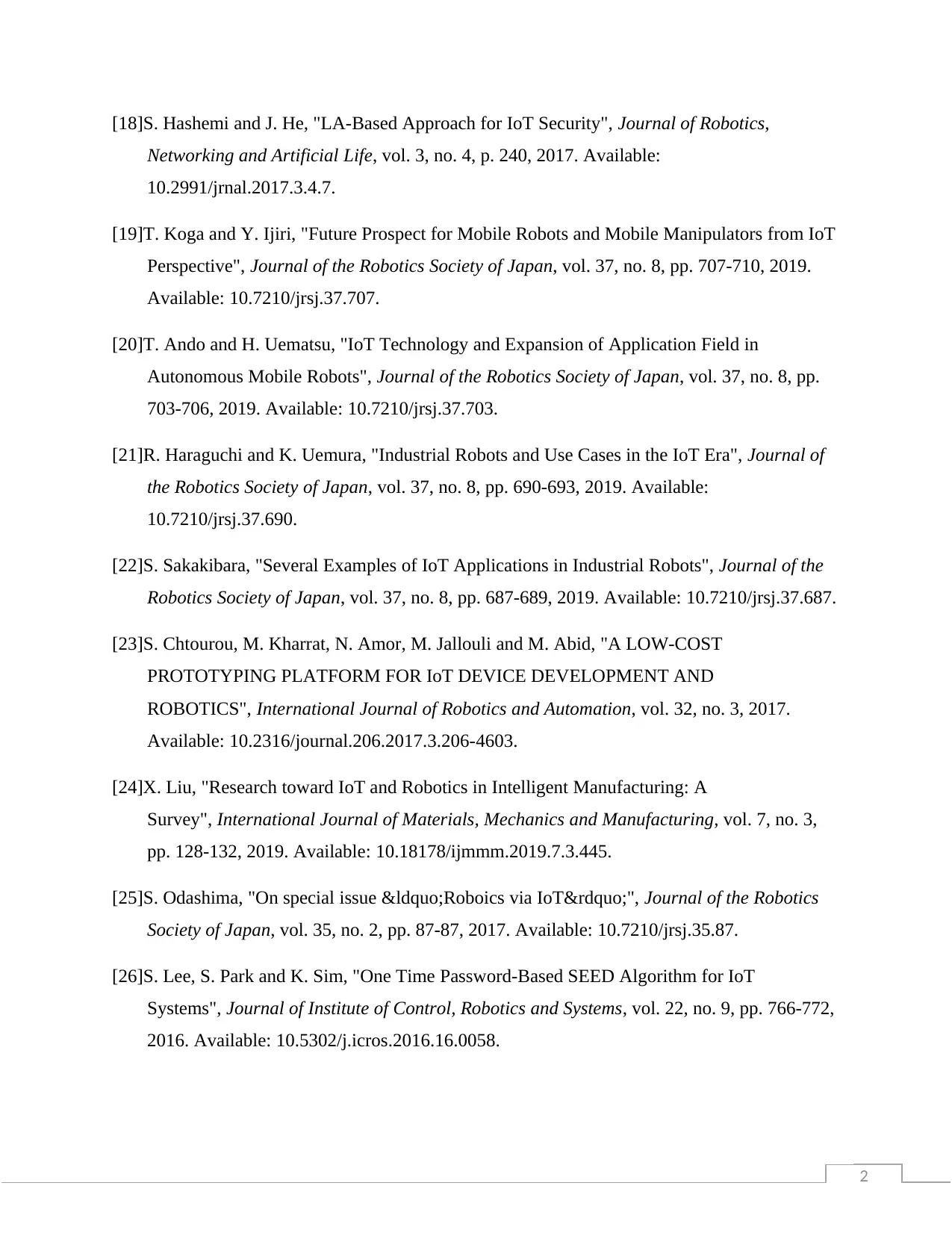
2
[18]S. Hashemi and J. He, "LA-Based Approach for IoT Security", Journal of Robotics,
Networking and Artificial Life, vol. 3, no. 4, p. 240, 2017. Available:
10.2991/jrnal.2017.3.4.7.
[19]T. Koga and Y. Ijiri, "Future Prospect for Mobile Robots and Mobile Manipulators from IoT
Perspective", Journal of the Robotics Society of Japan, vol. 37, no. 8, pp. 707-710, 2019.
Available: 10.7210/jrsj.37.707.
[20]T. Ando and H. Uematsu, "IoT Technology and Expansion of Application Field in
Autonomous Mobile Robots", Journal of the Robotics Society of Japan, vol. 37, no. 8, pp.
703-706, 2019. Available: 10.7210/jrsj.37.703.
[21]R. Haraguchi and K. Uemura, "Industrial Robots and Use Cases in the IoT Era", Journal of
the Robotics Society of Japan, vol. 37, no. 8, pp. 690-693, 2019. Available:
10.7210/jrsj.37.690.
[22]S. Sakakibara, "Several Examples of IoT Applications in Industrial Robots", Journal of the
Robotics Society of Japan, vol. 37, no. 8, pp. 687-689, 2019. Available: 10.7210/jrsj.37.687.
[23]S. Chtourou, M. Kharrat, N. Amor, M. Jallouli and M. Abid, "A LOW-COST
PROTOTYPING PLATFORM FOR IoT DEVICE DEVELOPMENT AND
ROBOTICS", International Journal of Robotics and Automation, vol. 32, no. 3, 2017.
Available: 10.2316/journal.206.2017.3.206-4603.
[24]X. Liu, "Research toward IoT and Robotics in Intelligent Manufacturing: A
Survey", International Journal of Materials, Mechanics and Manufacturing, vol. 7, no. 3,
pp. 128-132, 2019. Available: 10.18178/ijmmm.2019.7.3.445.
[25]S. Odashima, "On special issue “Roboics via IoT”", Journal of the Robotics
Society of Japan, vol. 35, no. 2, pp. 87-87, 2017. Available: 10.7210/jrsj.35.87.
[26]S. Lee, S. Park and K. Sim, "One Time Password-Based SEED Algorithm for IoT
Systems", Journal of Institute of Control, Robotics and Systems, vol. 22, no. 9, pp. 766-772,
2016. Available: 10.5302/j.icros.2016.16.0058.
[18]S. Hashemi and J. He, "LA-Based Approach for IoT Security", Journal of Robotics,
Networking and Artificial Life, vol. 3, no. 4, p. 240, 2017. Available:
10.2991/jrnal.2017.3.4.7.
[19]T. Koga and Y. Ijiri, "Future Prospect for Mobile Robots and Mobile Manipulators from IoT
Perspective", Journal of the Robotics Society of Japan, vol. 37, no. 8, pp. 707-710, 2019.
Available: 10.7210/jrsj.37.707.
[20]T. Ando and H. Uematsu, "IoT Technology and Expansion of Application Field in
Autonomous Mobile Robots", Journal of the Robotics Society of Japan, vol. 37, no. 8, pp.
703-706, 2019. Available: 10.7210/jrsj.37.703.
[21]R. Haraguchi and K. Uemura, "Industrial Robots and Use Cases in the IoT Era", Journal of
the Robotics Society of Japan, vol. 37, no. 8, pp. 690-693, 2019. Available:
10.7210/jrsj.37.690.
[22]S. Sakakibara, "Several Examples of IoT Applications in Industrial Robots", Journal of the
Robotics Society of Japan, vol. 37, no. 8, pp. 687-689, 2019. Available: 10.7210/jrsj.37.687.
[23]S. Chtourou, M. Kharrat, N. Amor, M. Jallouli and M. Abid, "A LOW-COST
PROTOTYPING PLATFORM FOR IoT DEVICE DEVELOPMENT AND
ROBOTICS", International Journal of Robotics and Automation, vol. 32, no. 3, 2017.
Available: 10.2316/journal.206.2017.3.206-4603.
[24]X. Liu, "Research toward IoT and Robotics in Intelligent Manufacturing: A
Survey", International Journal of Materials, Mechanics and Manufacturing, vol. 7, no. 3,
pp. 128-132, 2019. Available: 10.18178/ijmmm.2019.7.3.445.
[25]S. Odashima, "On special issue “Roboics via IoT”", Journal of the Robotics
Society of Japan, vol. 35, no. 2, pp. 87-87, 2017. Available: 10.7210/jrsj.35.87.
[26]S. Lee, S. Park and K. Sim, "One Time Password-Based SEED Algorithm for IoT
Systems", Journal of Institute of Control, Robotics and Systems, vol. 22, no. 9, pp. 766-772,
2016. Available: 10.5302/j.icros.2016.16.0058.
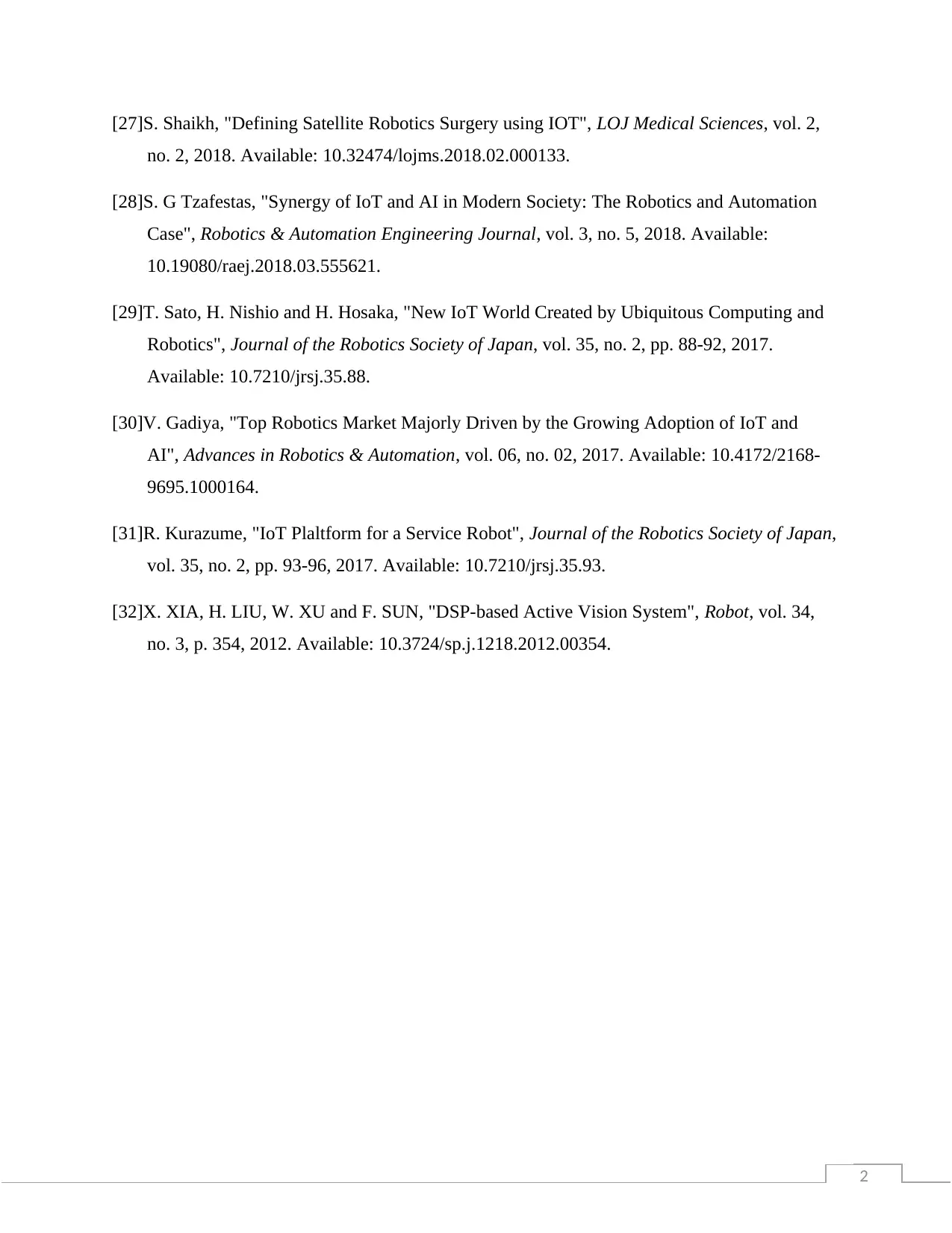
2
[27]S. Shaikh, "Defining Satellite Robotics Surgery using IOT", LOJ Medical Sciences, vol. 2,
no. 2, 2018. Available: 10.32474/lojms.2018.02.000133.
[28]S. G Tzafestas, "Synergy of IoT and AI in Modern Society: The Robotics and Automation
Case", Robotics & Automation Engineering Journal, vol. 3, no. 5, 2018. Available:
10.19080/raej.2018.03.555621.
[29]T. Sato, H. Nishio and H. Hosaka, "New IoT World Created by Ubiquitous Computing and
Robotics", Journal of the Robotics Society of Japan, vol. 35, no. 2, pp. 88-92, 2017.
Available: 10.7210/jrsj.35.88.
[30]V. Gadiya, "Top Robotics Market Majorly Driven by the Growing Adoption of IoT and
AI", Advances in Robotics & Automation, vol. 06, no. 02, 2017. Available: 10.4172/2168-
9695.1000164.
[31]R. Kurazume, "IoT Plaltform for a Service Robot", Journal of the Robotics Society of Japan,
vol. 35, no. 2, pp. 93-96, 2017. Available: 10.7210/jrsj.35.93.
[32]X. XIA, H. LIU, W. XU and F. SUN, "DSP-based Active Vision System", Robot, vol. 34,
no. 3, p. 354, 2012. Available: 10.3724/sp.j.1218.2012.00354.
[27]S. Shaikh, "Defining Satellite Robotics Surgery using IOT", LOJ Medical Sciences, vol. 2,
no. 2, 2018. Available: 10.32474/lojms.2018.02.000133.
[28]S. G Tzafestas, "Synergy of IoT and AI in Modern Society: The Robotics and Automation
Case", Robotics & Automation Engineering Journal, vol. 3, no. 5, 2018. Available:
10.19080/raej.2018.03.555621.
[29]T. Sato, H. Nishio and H. Hosaka, "New IoT World Created by Ubiquitous Computing and
Robotics", Journal of the Robotics Society of Japan, vol. 35, no. 2, pp. 88-92, 2017.
Available: 10.7210/jrsj.35.88.
[30]V. Gadiya, "Top Robotics Market Majorly Driven by the Growing Adoption of IoT and
AI", Advances in Robotics & Automation, vol. 06, no. 02, 2017. Available: 10.4172/2168-
9695.1000164.
[31]R. Kurazume, "IoT Plaltform for a Service Robot", Journal of the Robotics Society of Japan,
vol. 35, no. 2, pp. 93-96, 2017. Available: 10.7210/jrsj.35.93.
[32]X. XIA, H. LIU, W. XU and F. SUN, "DSP-based Active Vision System", Robot, vol. 34,
no. 3, p. 354, 2012. Available: 10.3724/sp.j.1218.2012.00354.
1 out of 28
Your All-in-One AI-Powered Toolkit for Academic Success.
+13062052269
info@desklib.com
Available 24*7 on WhatsApp / Email
![[object Object]](/_next/static/media/star-bottom.7253800d.svg)
Unlock your academic potential
© 2024 | Zucol Services PVT LTD | All rights reserved.


